Paul van Yperen's Blog, page 200
April 14, 2020
Lya Mara
Lya Mara (1893-1969) was one of the biggest stars of the German silent cinema. Some immensely successful silent operettas presented her the perfect Viennese Girl. Hundreds of postcards and trading cards cemented her stardom, which was even the subject of a novel, published in 100 episodes between 1927 and 1928. Her career virtually ended after the arrival of sound film. Recently, Marlene Pilaete discovered new facts about this forgotten diva.
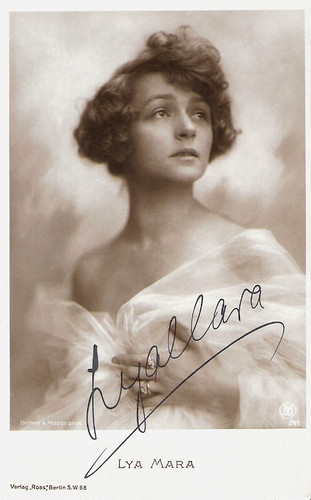
German postcard by Ross Verlag, no. 241, 1919-1924. Photo: Becker & Maass.
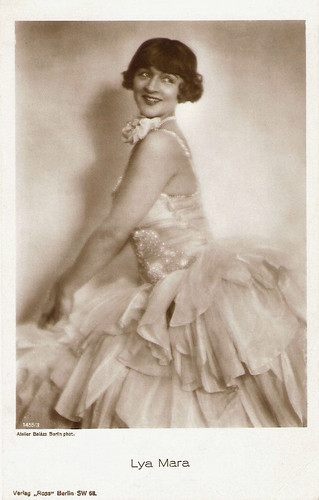
German postcard by Ross Verlag, no. 1455/3, 1927-1928. Photo: Atelier Balázs, Berlin.
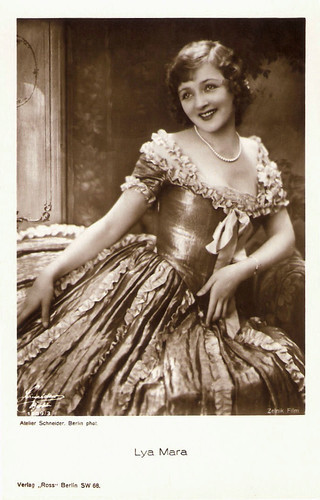
German postcard by Ross Verlag, no. 1889/3, 1927-1928. Photo: Atelier Schneider, Berlin / Zelnik-Film.
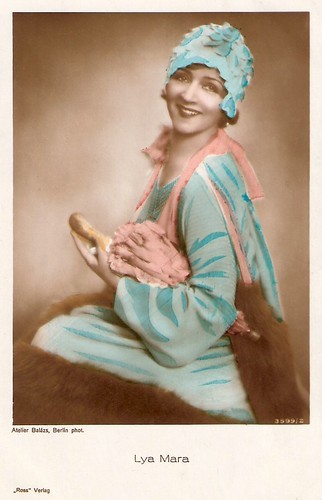
German postcard by Ross Verlag, no. 3599/1, 1928-1929. Photo: Atelier Balázs, Berlin.
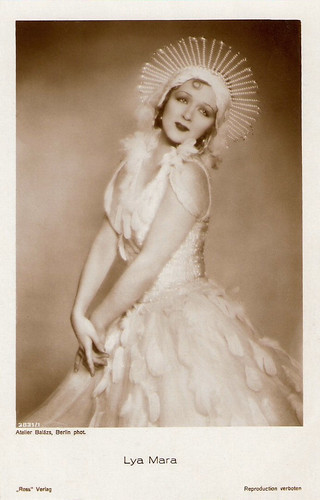
German postcard by Ross Verlag, no. 3831/1, 1928-1929. Photo: Atelier Balázs, Berlin.
Prima Ballerina
Lya Mara was born as Aleksandra Gudowiczóna in a Polish family in Riga, Russian Empire (now Latvia) in 1893 or 1897. She was the daughter of a civil servant and went to a Catholic boarding school.
As a young girl, she wanted to become a chemist, like Marie Curie, the then famous French woman scientist who was also Polish-born, but instead, Lya went to the ballet school of Riga. One year later, she was already a solo dancer and in the following years, she danced for the Riga State theatre and became astonishingly famous. This success was crowned with her promotion to prima ballerina in 1913.
Just before World War I, Lya moved with her family to Warsaw. Credited as Mia Mara, she played her first small part in the short silent comedy Wsciekly rywal/The Rival (Aleksander Hertz, 1916), and soon thereafter she played another part in Bestia/The Polish Dancer (Aleksander Hertz, 1917). Star of this film was another Polish actress, Pola Negri , who would make an extraordinary career in Germany and Hollywood. Negri left for Berlin, and soon Lya Mara would follow her steps.
Newspaper articles and pictures of Mara had appeared in Berlin newspapers, and she was spotted by the young and energetic actor-director-producer Friedrich Zelnik (later credited as Frederic Zelnik ). He summoned her to Berlin. After some screen tests, she signed a contract that obligated her for a total of seven pictures with Zelnik.
Among their first films were Das Geschlecht der Schelme/The sex of the Scoundrel (Alfred Halm, 1917) opposite Zelnik himself, Halkas Gelöbnis/Halka's Vow (Alfred Halm, 1918) opposite Hans Albers , Die Rose von Dschiandur/The Rose of Dschiandur (Alfred Halm, 1918) again opposite Zelnik, and Die Serenyi (Alfred Halm, 1918) opposite Conrad Veidt .
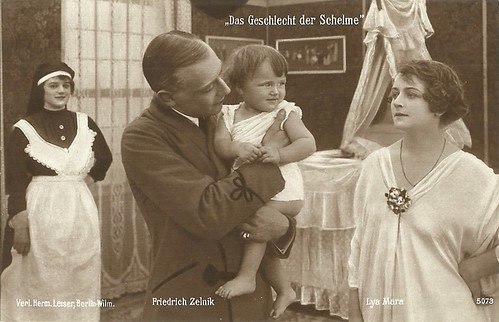
German postcard by Verl. Hermann Leiser, Berlin, no. 5073. Photo: Berliner Film-Manufaktur. Lya Mara and Friedrich Zelnik in Das Geschlecht der Schelme/The sex of the scroundel (H. Fredall a.k.a. Alfred Halm, 1917). Alfred Halm directed this film and the following films under his regular pseudonym H. Fredall, while he also scripted the film.
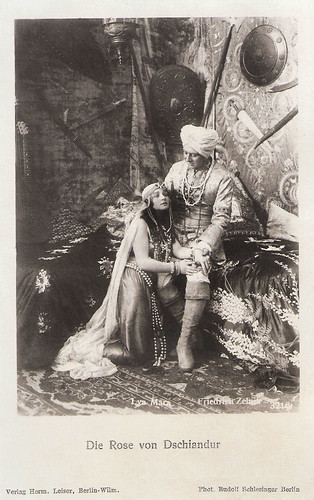
German postcard by Verlag Hermann Leiser, Berlin-Wilm, no. 3216. Photo: Rudolph Schlesinger. Photo: Berliner Film-Manufaktur. Friedrich Zelnik and Lya Mara in Die Rose von Dschiandur/The Rose of Dschiandur (Alfred Halm, 1918).
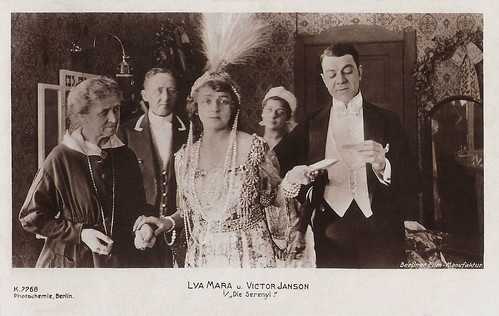
German postcard by Photochemie, Berlin, no. K. 2268. Photo: Berliner Film-Manufaktur. Lya Mara and Victor Janson in Die Serenyi (Alfred Halm, 1918). This is one of two cards Photchemie issued on this film.
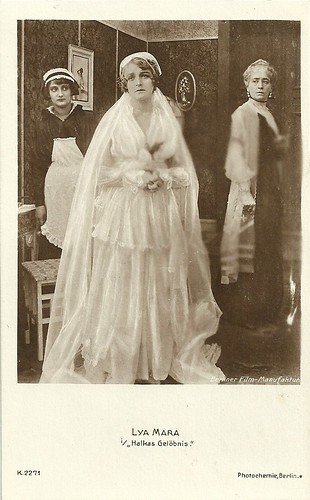
German postcard by Photochemie, Berlin, no. K. 2271/2. Photo: Berliner Film-Manufaktur. Lya Mara in Halkas Gelöbnis/Halka's Vow (Alfred Halm, 1918).
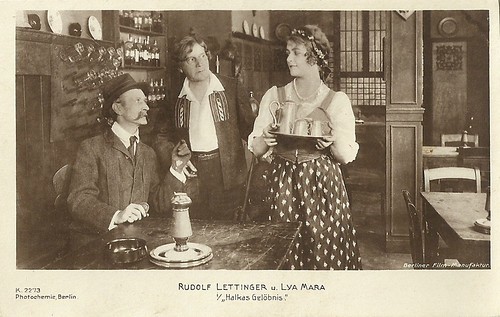
German postcard by Photochemie, Berlin, no. K. 2273. Photo: Berliner Film-Manufaktur. Lya Mara in Halkas Gelöbnis/Halka's Vow (H. Fredall a.k.a. Alfred Halm, 1918). This is one of a set of three cards that Photochemie issued on the film.
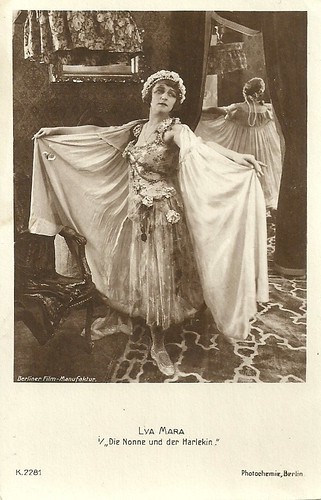
German postcard by Photochemie, Berlin, no. K. 2281. Photo: Berliner Film-Manufaktur. Lya Mara in Die Nonne und der Harlekin/The Nun and the Harlequin (Alfred Halm, 1918). This one of three cards Photochemie issued on the film.
Immensely Successful Operettas
Friedrich Zelnik and Lya Mara married in 1918. Zelnik promoted her to a major star in Germany. Among the following films, he directed and produced with her were Manon (1919), Charlotte Corday (1919), and Anna Karenina (1919) with Johannes Riemann .
From 1920 on, Zelnik's film production company was named Zelnik-Mara-Film GmbH. Lya starred in lightweight fare like Die Ehe der Fürstin Demidoff/The Marriage of Princess Demidoff (1921), and Das Mädel vom Picadilly/The Girl from Picadilly (1921), in which she either played noble ladies or naïve girls from the countryside.
From 1924 on, she only made two Zelnik films a year, among them immensely successful operettas like Die Försterchristel/The Bohemian Dancer (1926), An der schönen blauen Donau/The Beautiful Blue Danube (1926), and Das tanzende Wien/Dancing Vienna (1927), often with Harry Liedtke or Alfred Abel as her screen partner.
Lya Mara perfectly embodied the Viennese Girl, and she enjoyed great popularity all over Europe. Her stardom also was the subject of a novel, 'Lya. Der Herzensroman einer Kinokönigin' (Lya, The Heart Novel of a Cinema Queen), which was published in 100 episodes between 1927 and 1928.
Lya Mara and her husband became real celebrities and received at their home many known artists. Her popularity was further cemented by hundreds of her photographs issued as postcards, chocolate and cigarettes trade cards.
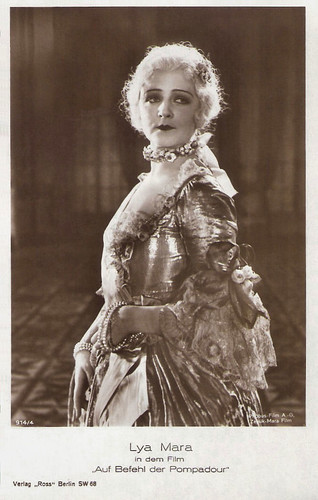
German postcard by Ross Verlag, no. 914/4, 1925-1926. Photo: Phoebus Film / Zelnik-Mara Film. Lya Mara in Auf Befehl der Pompadour/By Order of Pompadour (Friedrich Zelnik, 1924).
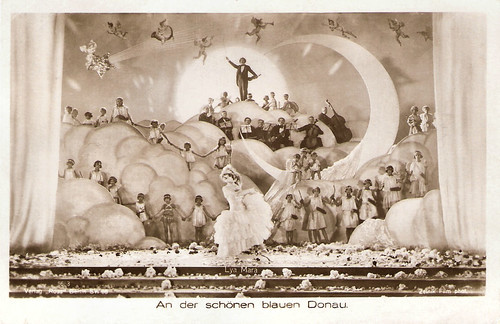
German postcard by Ross Verlag, no. 56/3, 1925-1926. Photo: Zelnik Film. Publicity still for An der schönen blauen Donau/The Beautiful Blue Danube (Friedrich Zelnik, 1926).
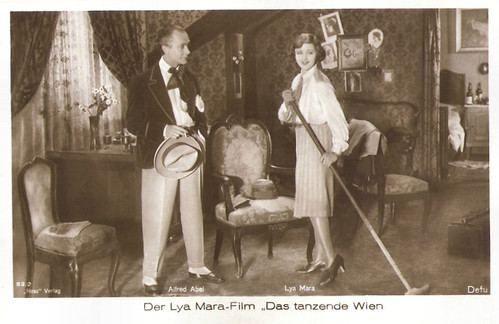
German postcard by Ross Verlag, no. 82/2. Photo: Defu. Alfred Abel and Lya Mara in Das tanzende Wien/Dancing Vienna (Friedrich Zelnik, 1927).
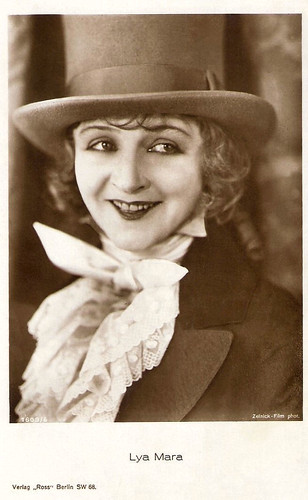
German postcard by Ross Verlag, no. 1608/6, 1927-1928. Photo: Zelnick-Film. Lya Mara in Die lachende Grille/The Merry Madcap (Friedrich Zelnik, 1926)
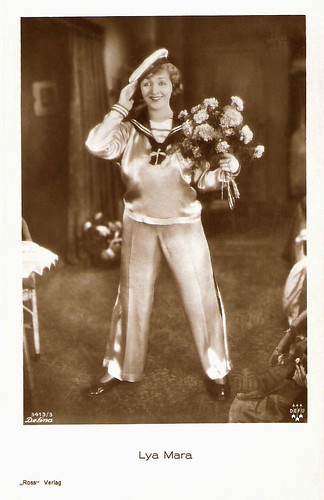
German postcard by Ross Verlag, no. 3413/3, 1928-1929. Photo: Defina / DEFU.
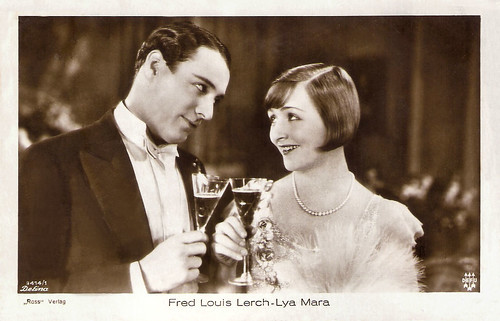
German postcard by Ross Verlag, no. 3414/1, 1928-1929. Photo: Defina / DEFU. Fred Louis Lerch and Lya Mara in Heut tanzt Mariett/Today dances Mariett (Friedrich Zelnik, 1928). Collection: Geoffrey Donaldson Institute.
Lost Traces
A serious car accident at the end of the 1920s interrupted Lya Mara's career. There was an immensely huge sympathy from the audience, but somehow she could not adapt her acting to the sound cinema, introduced in Germany in 1929.
While Friedrich Zelnik became the first director in Germany who post-synchronised foreign films, Lya Mara's only film from the sound era is Jeder fragt nach Erika/Everyone Asks for Erika (Friedrich Zelnik, 1931).
In 1932, just before Adolf Hitler took over the power in Germany, Lya Mara and Friedrich Zelnik went into exile in London. There is no record of her acting there, although her husband continued to direct and produce films in England and The Netherlands until 1939.
Friedrich Zelnik died in London in 1950, and since then all traces of his wife were lost for a long time. Lya Mara probably spent her last years with her sister in Switzerland and most sources indicate that she died there in 1960 at the age of 62.
However, 'Ms. Sherlock' Marlene Pilaete discovered the correct facts: "Some passionate historians have found mention of her death in local newspapers. How lucky we are to have such people making research. For example, the Nouvelle Revue de Lausanne mentions on the 6th of November 1969 in its obituary page "Alexandra Zelnik-Gudowicz, 76 years old". At the time, nobody knew that she had been a famous movie star. Please note that, if she was 76 years old when she passed away, it seems that she was born in 1893 and not 1897. Maybe another case of 'rejuvenation'… It wouldn’t be the first time… especially regarding actresses."
So, Lya Mara settled down in Lausanne, Switzerland in 1966. She passed away in that city on 1 November 1969 and she was buried in the cemetery of Bois-de-Vaux. Her grave has been disaffected in 2007.
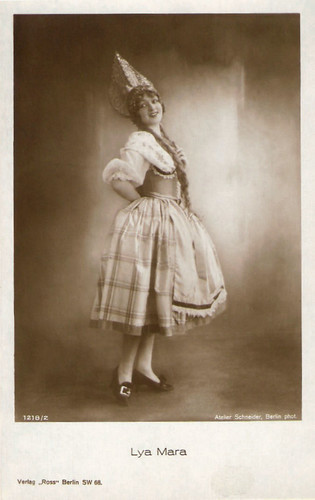
German postcard by Ross Verlag, no. 1218/2, 1927-1928. Photo: Atelier Schneider, Berlin.
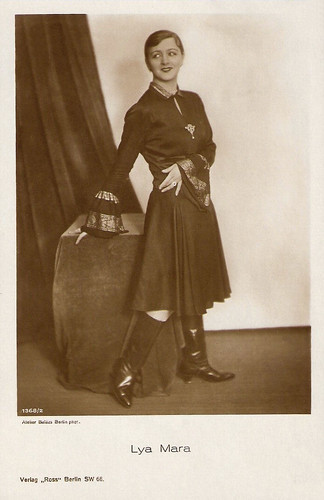
German postcard by Ross Verlag, no. 1368/2, 1927-1928. Photo: Atelier Balázs, Berlin.
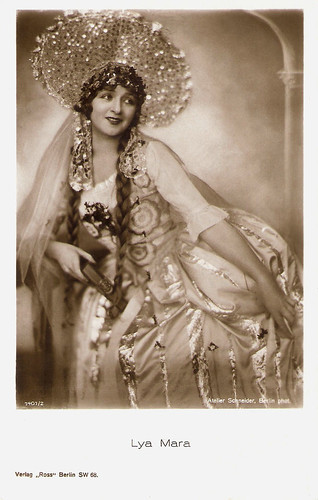
German postcard by Ross Verlag, no. 1401/2, 1927-1928. Photo: Atelier Schneider, Berlin.
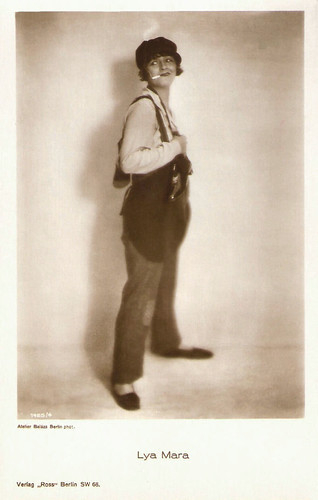
German postcard by Ross Verlag, no. 1455/4, 1927-1928. Photo: Atelier Balázs, Berlin.
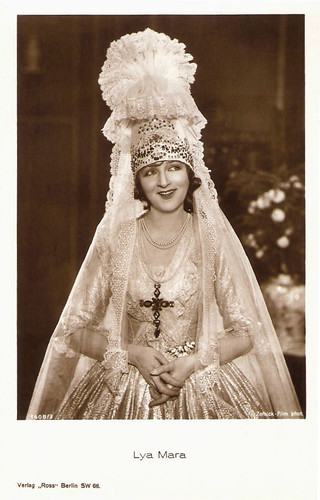
German postcard by Ross Verlag, no. 1608/3, 1927-1928. Photo: F. Zelnick-Film.
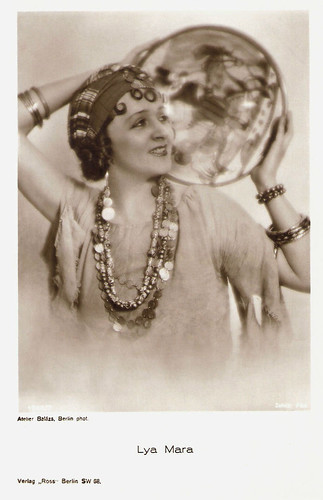
German postcard by Ross Verlag, no. 1740/7, 1927-1928. Photo: Atelier Balázs, Berlin / Zelnick Film.
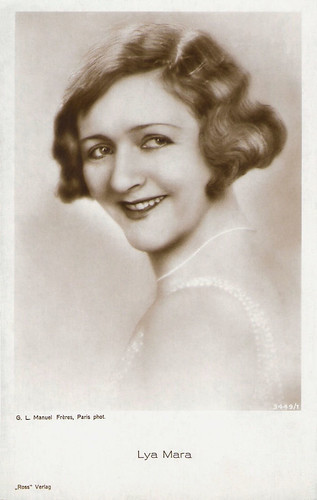
German postcard by Ross Verlag, no. 3449/1, 1928-1929. Photo: G.L. Manuel Frères, Paris.
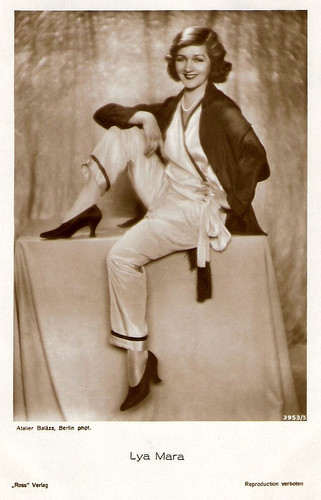
German postcard by Ross Verlag, no. 3953/5, 1928-1929. Photo: Atelier Balázs, Berlin.
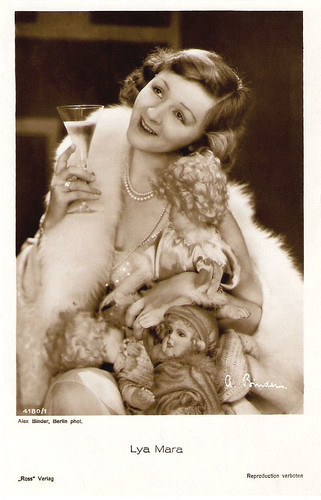
German postcard by Ross Verlag, no. 4180/1, 1929-1930. Photo: Alex Binder, Berlin.
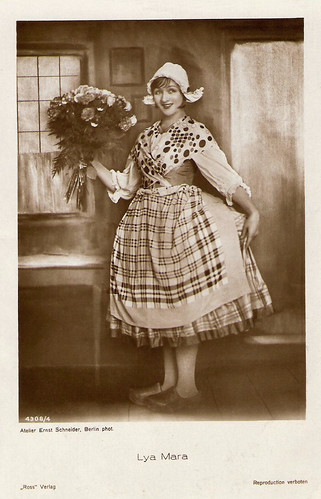
German postcard by Ross Verlag, no. 4308/4, 1929-1930. Photo: Ernst Schneider, Berlin.
Sources: Marlene Pilaete (La Collectionneuse - French), Thomas Staedeli (Cyranos), Filmportal.de, Wikipedia, and .

German postcard by Ross Verlag, no. 241, 1919-1924. Photo: Becker & Maass.

German postcard by Ross Verlag, no. 1455/3, 1927-1928. Photo: Atelier Balázs, Berlin.

German postcard by Ross Verlag, no. 1889/3, 1927-1928. Photo: Atelier Schneider, Berlin / Zelnik-Film.

German postcard by Ross Verlag, no. 3599/1, 1928-1929. Photo: Atelier Balázs, Berlin.

German postcard by Ross Verlag, no. 3831/1, 1928-1929. Photo: Atelier Balázs, Berlin.
Prima Ballerina
Lya Mara was born as Aleksandra Gudowiczóna in a Polish family in Riga, Russian Empire (now Latvia) in 1893 or 1897. She was the daughter of a civil servant and went to a Catholic boarding school.
As a young girl, she wanted to become a chemist, like Marie Curie, the then famous French woman scientist who was also Polish-born, but instead, Lya went to the ballet school of Riga. One year later, she was already a solo dancer and in the following years, she danced for the Riga State theatre and became astonishingly famous. This success was crowned with her promotion to prima ballerina in 1913.
Just before World War I, Lya moved with her family to Warsaw. Credited as Mia Mara, she played her first small part in the short silent comedy Wsciekly rywal/The Rival (Aleksander Hertz, 1916), and soon thereafter she played another part in Bestia/The Polish Dancer (Aleksander Hertz, 1917). Star of this film was another Polish actress, Pola Negri , who would make an extraordinary career in Germany and Hollywood. Negri left for Berlin, and soon Lya Mara would follow her steps.
Newspaper articles and pictures of Mara had appeared in Berlin newspapers, and she was spotted by the young and energetic actor-director-producer Friedrich Zelnik (later credited as Frederic Zelnik ). He summoned her to Berlin. After some screen tests, she signed a contract that obligated her for a total of seven pictures with Zelnik.
Among their first films were Das Geschlecht der Schelme/The sex of the Scoundrel (Alfred Halm, 1917) opposite Zelnik himself, Halkas Gelöbnis/Halka's Vow (Alfred Halm, 1918) opposite Hans Albers , Die Rose von Dschiandur/The Rose of Dschiandur (Alfred Halm, 1918) again opposite Zelnik, and Die Serenyi (Alfred Halm, 1918) opposite Conrad Veidt .

German postcard by Verl. Hermann Leiser, Berlin, no. 5073. Photo: Berliner Film-Manufaktur. Lya Mara and Friedrich Zelnik in Das Geschlecht der Schelme/The sex of the scroundel (H. Fredall a.k.a. Alfred Halm, 1917). Alfred Halm directed this film and the following films under his regular pseudonym H. Fredall, while he also scripted the film.

German postcard by Verlag Hermann Leiser, Berlin-Wilm, no. 3216. Photo: Rudolph Schlesinger. Photo: Berliner Film-Manufaktur. Friedrich Zelnik and Lya Mara in Die Rose von Dschiandur/The Rose of Dschiandur (Alfred Halm, 1918).

German postcard by Photochemie, Berlin, no. K. 2268. Photo: Berliner Film-Manufaktur. Lya Mara and Victor Janson in Die Serenyi (Alfred Halm, 1918). This is one of two cards Photchemie issued on this film.

German postcard by Photochemie, Berlin, no. K. 2271/2. Photo: Berliner Film-Manufaktur. Lya Mara in Halkas Gelöbnis/Halka's Vow (Alfred Halm, 1918).

German postcard by Photochemie, Berlin, no. K. 2273. Photo: Berliner Film-Manufaktur. Lya Mara in Halkas Gelöbnis/Halka's Vow (H. Fredall a.k.a. Alfred Halm, 1918). This is one of a set of three cards that Photochemie issued on the film.

German postcard by Photochemie, Berlin, no. K. 2281. Photo: Berliner Film-Manufaktur. Lya Mara in Die Nonne und der Harlekin/The Nun and the Harlequin (Alfred Halm, 1918). This one of three cards Photochemie issued on the film.
Immensely Successful Operettas
Friedrich Zelnik and Lya Mara married in 1918. Zelnik promoted her to a major star in Germany. Among the following films, he directed and produced with her were Manon (1919), Charlotte Corday (1919), and Anna Karenina (1919) with Johannes Riemann .
From 1920 on, Zelnik's film production company was named Zelnik-Mara-Film GmbH. Lya starred in lightweight fare like Die Ehe der Fürstin Demidoff/The Marriage of Princess Demidoff (1921), and Das Mädel vom Picadilly/The Girl from Picadilly (1921), in which she either played noble ladies or naïve girls from the countryside.
From 1924 on, she only made two Zelnik films a year, among them immensely successful operettas like Die Försterchristel/The Bohemian Dancer (1926), An der schönen blauen Donau/The Beautiful Blue Danube (1926), and Das tanzende Wien/Dancing Vienna (1927), often with Harry Liedtke or Alfred Abel as her screen partner.
Lya Mara perfectly embodied the Viennese Girl, and she enjoyed great popularity all over Europe. Her stardom also was the subject of a novel, 'Lya. Der Herzensroman einer Kinokönigin' (Lya, The Heart Novel of a Cinema Queen), which was published in 100 episodes between 1927 and 1928.
Lya Mara and her husband became real celebrities and received at their home many known artists. Her popularity was further cemented by hundreds of her photographs issued as postcards, chocolate and cigarettes trade cards.

German postcard by Ross Verlag, no. 914/4, 1925-1926. Photo: Phoebus Film / Zelnik-Mara Film. Lya Mara in Auf Befehl der Pompadour/By Order of Pompadour (Friedrich Zelnik, 1924).

German postcard by Ross Verlag, no. 56/3, 1925-1926. Photo: Zelnik Film. Publicity still for An der schönen blauen Donau/The Beautiful Blue Danube (Friedrich Zelnik, 1926).

German postcard by Ross Verlag, no. 82/2. Photo: Defu. Alfred Abel and Lya Mara in Das tanzende Wien/Dancing Vienna (Friedrich Zelnik, 1927).

German postcard by Ross Verlag, no. 1608/6, 1927-1928. Photo: Zelnick-Film. Lya Mara in Die lachende Grille/The Merry Madcap (Friedrich Zelnik, 1926)

German postcard by Ross Verlag, no. 3413/3, 1928-1929. Photo: Defina / DEFU.

German postcard by Ross Verlag, no. 3414/1, 1928-1929. Photo: Defina / DEFU. Fred Louis Lerch and Lya Mara in Heut tanzt Mariett/Today dances Mariett (Friedrich Zelnik, 1928). Collection: Geoffrey Donaldson Institute.
Lost Traces
A serious car accident at the end of the 1920s interrupted Lya Mara's career. There was an immensely huge sympathy from the audience, but somehow she could not adapt her acting to the sound cinema, introduced in Germany in 1929.
While Friedrich Zelnik became the first director in Germany who post-synchronised foreign films, Lya Mara's only film from the sound era is Jeder fragt nach Erika/Everyone Asks for Erika (Friedrich Zelnik, 1931).
In 1932, just before Adolf Hitler took over the power in Germany, Lya Mara and Friedrich Zelnik went into exile in London. There is no record of her acting there, although her husband continued to direct and produce films in England and The Netherlands until 1939.
Friedrich Zelnik died in London in 1950, and since then all traces of his wife were lost for a long time. Lya Mara probably spent her last years with her sister in Switzerland and most sources indicate that she died there in 1960 at the age of 62.
However, 'Ms. Sherlock' Marlene Pilaete discovered the correct facts: "Some passionate historians have found mention of her death in local newspapers. How lucky we are to have such people making research. For example, the Nouvelle Revue de Lausanne mentions on the 6th of November 1969 in its obituary page "Alexandra Zelnik-Gudowicz, 76 years old". At the time, nobody knew that she had been a famous movie star. Please note that, if she was 76 years old when she passed away, it seems that she was born in 1893 and not 1897. Maybe another case of 'rejuvenation'… It wouldn’t be the first time… especially regarding actresses."
So, Lya Mara settled down in Lausanne, Switzerland in 1966. She passed away in that city on 1 November 1969 and she was buried in the cemetery of Bois-de-Vaux. Her grave has been disaffected in 2007.

German postcard by Ross Verlag, no. 1218/2, 1927-1928. Photo: Atelier Schneider, Berlin.

German postcard by Ross Verlag, no. 1368/2, 1927-1928. Photo: Atelier Balázs, Berlin.

German postcard by Ross Verlag, no. 1401/2, 1927-1928. Photo: Atelier Schneider, Berlin.

German postcard by Ross Verlag, no. 1455/4, 1927-1928. Photo: Atelier Balázs, Berlin.

German postcard by Ross Verlag, no. 1608/3, 1927-1928. Photo: F. Zelnick-Film.

German postcard by Ross Verlag, no. 1740/7, 1927-1928. Photo: Atelier Balázs, Berlin / Zelnick Film.

German postcard by Ross Verlag, no. 3449/1, 1928-1929. Photo: G.L. Manuel Frères, Paris.

German postcard by Ross Verlag, no. 3953/5, 1928-1929. Photo: Atelier Balázs, Berlin.

German postcard by Ross Verlag, no. 4180/1, 1929-1930. Photo: Alex Binder, Berlin.

German postcard by Ross Verlag, no. 4308/4, 1929-1930. Photo: Ernst Schneider, Berlin.
Sources: Marlene Pilaete (La Collectionneuse - French), Thomas Staedeli (Cyranos), Filmportal.de, Wikipedia, and .
Published on April 14, 2020 22:00
April 13, 2020
White Shadows in the South Seas (1928)
White Shadows in the South Seas (W.S. Van Dyke, Robert Flaherty, 1928) started a series with exotic films in which Western pioneers travelled to Polynesian islands or other far-away places. In White Shadows in the South Seas, Monte Blue starred as the traveller and Raquel Torres debuted as the beautiful island girl he falls in love with. The film was shot on Tahiti, 4000 miles from Hollywood, a rarity for the time.
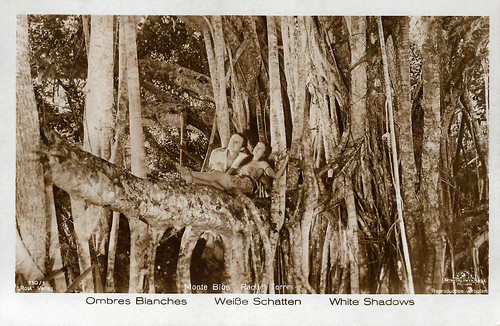
German postcard. Ross Verlag, Berlin, no. 110/1. Photo: Metro-Goldwyn-Mayer. Monte Blue and Raquel Torres in White Shadows in the South Seas (W.S. Van Dyke, Robert Flaherty, 1928).
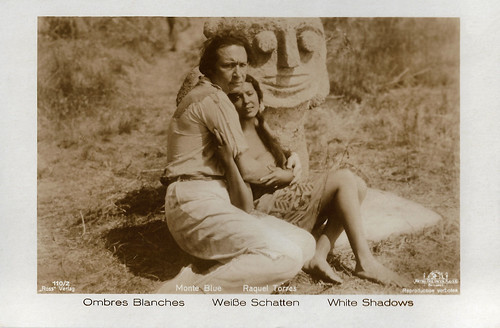
German postcard by Ross Verlag, Berlin, no. 110/2. Photo: Metro-Goldwyn-Mayer. Monte Blue and Raquel Torres in White Shadows in the South Seas (W.S. Van Dyke, Robert Flaherty, MGM 1928).
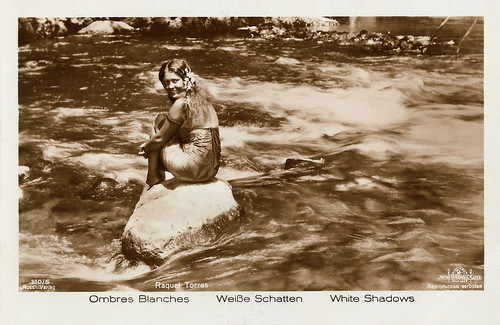
German postcard by Ross Verlag, no. 110/5. Photo: Metro-Goldwyn-Mayer. Raquel Torres in White Shadows in the South Seas (W.S. Van Dyke, 1928).
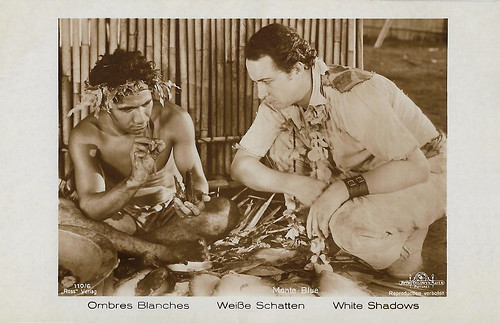
German postcard by Ross Verlag, no. 110/6. Photo: Metro-Goldwyn-Mayer. Monte Blue in White Shadows in the South Seas (W.S. Van Dyke, Robert Flaherty, 1928).
A masterful blend of drama and documentary
In White Shadows in the South Seas (W.S. Van Dyke, Robert Flaherty, 1928), Monte Blue plays Dr. Matthew Lloyd, an alcoholic doctor who is disgusted by the way white men have cheated, robbed and exploited the trusting natives of the Polynesian Islands. He makes an enemy of Sebastian (Robert Anderson), an evil trader, who manages to get Lloyd on to a plague-ridden boat, which, during a typhoon, is shipwrecked on another uncharted island. The Pacific island is still untouched by the 'white shadows', and Lloyd falls in love with native girl Fayaway (Raquel Torres).
When Lloyd rescues the chief's young son from drowning the island people make him a God. Enchanted by the idyllic lifestyle of the islanders, Lloyd reacts with horror when he sees Sebastian's group sail into view, bringing their usual seductive trinkets of alcohol and cigarettes. Attempting to quell the invasion, Blue is killed by one of Sebastian's men. As her island falls victim to civilisation, Fayaway mourns over her lover's grave.
In 1927, MGM production head Irving Thalberg was in the hospital recuperating and during his stay he read the travel book 'White Shadows in the South Seas' by Frederick O'Brien, who had spent a year in the South Pacific with Marquesas Islanders. Thalberg decided to make O'Brien's book into an epic adventure film and he selected Robert Flaherty, a famed documentary maker, to direct. Thalberg had been very impressed with his documentary Moana (1926). W.S. Van Dyke, who had mainly worked on Westerns, was named as assistant director. The film began production in 1927 as a co-venture between Flaherty, Cosmopolitan and MGM.
White Shadows in the South Seas was filmed on location in Tahiti, even though the opening credits claim it was shot on location in the Marquesas Islands with "authentic" islanders. Robert Flaherty had plenty experience with the South Seas: he had lived with his wife and children in Samoa from April 1923 to December 1924 filming Moana. He was at first given complete artistic control, but he began to falter in terms of keeping cast and crew organised.
For Metro-Goldwyn-Mayer, White Shadows was a special project. It was to be MGM's first sound film, with a pre-recorded soundtrack, and the first film in which Leo, the MGM lion roared during the introduction. The soundtrack consisted of a romantic score by William Axt and David Mendoza, with a few sound effects such as wind howling, a storm, trees ruffling and one faint word "Hello".
Flaherty moved too slowly to suit MGM. More and more directorial authority was relegated to Flaherty's assistant, the phenomenally fast W. S. Van Dyke who was known as "One Take Woody", and would go on to an Oscar nomination for The Thin Man (1934). Frustrated, Flaherty resigned although some reports claim that he fell ill and was taken off the project. The film became solely the responsibility of Van Dyke.
The cinematographer was Clyde De Vinna, whose beautiful, vivid photography justly won the Oscar for Best Cinematography. There are some awesome underwater sequences, featuring octopuses, sharks, pearl-diving and an unforgettable, intimate scene in which the 'white god' teaches the island girl to whistle.
Hal Erickson at AllMovie : "Despite the wails from the pro-Flaherty camp about "compromise" and "bastardization", the finished White Shadows in the South Seas is a superlative work. Loosely based on a 1919 book by Frederick O'Brien, the film charts the denigration of the South Sea islands and its denizens thanks to the intervention of white civilization. (...)
Gorgeously photographed, White Shadows in the South Seas is a masterful blend of drama and documentary. Most surviving prints do not include the clumsily constructed talkie sequences, wherein Monte Blue teaches Raquel Torres how to whistle (this scene works far better when conveyed silently)."
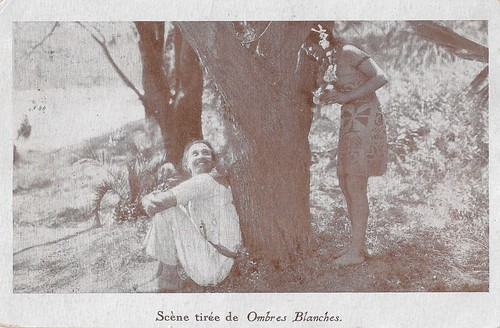
French postcard for the Parisian Ciné Madeleine. Photo: Metro-Goldwyn-Mayer. Monte Blue and Raquel Torres in White Shadows in the South Seas (W.S. Van Dyke, Robert Flaherty, 1928).
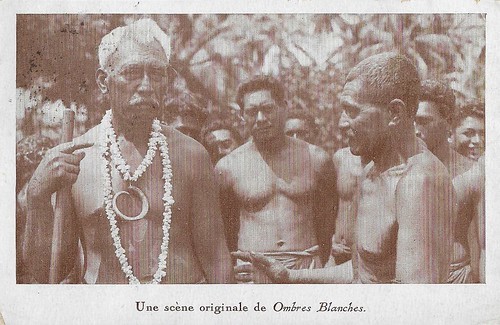
French postcard for the Parisian Ciné Madeleine. Photo: Metro-Goldwyn-Mayer. Nonprofessional actors from Tahiti in White Shadows in the South Seas (W.S. Van Dyke, Robert Flaherty, 1928).
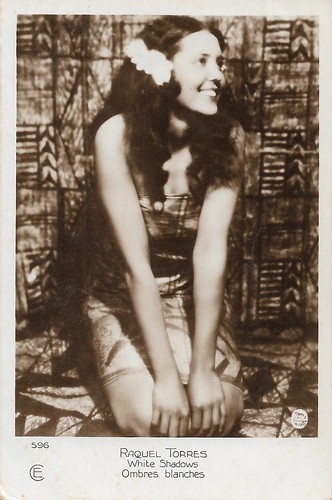
French postcard by Cinémagazine-Editions, no. 596. Photo: Metro-Goldwyn-Mayer. Raquel Torres in White Shadows in the South Seas (W.S. Van Dyke, Robert Flaherty, 1928).
Source: Hal Erickson (AllMovie), Wikipedia and IMDb.

German postcard. Ross Verlag, Berlin, no. 110/1. Photo: Metro-Goldwyn-Mayer. Monte Blue and Raquel Torres in White Shadows in the South Seas (W.S. Van Dyke, Robert Flaherty, 1928).

German postcard by Ross Verlag, Berlin, no. 110/2. Photo: Metro-Goldwyn-Mayer. Monte Blue and Raquel Torres in White Shadows in the South Seas (W.S. Van Dyke, Robert Flaherty, MGM 1928).

German postcard by Ross Verlag, no. 110/5. Photo: Metro-Goldwyn-Mayer. Raquel Torres in White Shadows in the South Seas (W.S. Van Dyke, 1928).

German postcard by Ross Verlag, no. 110/6. Photo: Metro-Goldwyn-Mayer. Monte Blue in White Shadows in the South Seas (W.S. Van Dyke, Robert Flaherty, 1928).
A masterful blend of drama and documentary
In White Shadows in the South Seas (W.S. Van Dyke, Robert Flaherty, 1928), Monte Blue plays Dr. Matthew Lloyd, an alcoholic doctor who is disgusted by the way white men have cheated, robbed and exploited the trusting natives of the Polynesian Islands. He makes an enemy of Sebastian (Robert Anderson), an evil trader, who manages to get Lloyd on to a plague-ridden boat, which, during a typhoon, is shipwrecked on another uncharted island. The Pacific island is still untouched by the 'white shadows', and Lloyd falls in love with native girl Fayaway (Raquel Torres).
When Lloyd rescues the chief's young son from drowning the island people make him a God. Enchanted by the idyllic lifestyle of the islanders, Lloyd reacts with horror when he sees Sebastian's group sail into view, bringing their usual seductive trinkets of alcohol and cigarettes. Attempting to quell the invasion, Blue is killed by one of Sebastian's men. As her island falls victim to civilisation, Fayaway mourns over her lover's grave.
In 1927, MGM production head Irving Thalberg was in the hospital recuperating and during his stay he read the travel book 'White Shadows in the South Seas' by Frederick O'Brien, who had spent a year in the South Pacific with Marquesas Islanders. Thalberg decided to make O'Brien's book into an epic adventure film and he selected Robert Flaherty, a famed documentary maker, to direct. Thalberg had been very impressed with his documentary Moana (1926). W.S. Van Dyke, who had mainly worked on Westerns, was named as assistant director. The film began production in 1927 as a co-venture between Flaherty, Cosmopolitan and MGM.
White Shadows in the South Seas was filmed on location in Tahiti, even though the opening credits claim it was shot on location in the Marquesas Islands with "authentic" islanders. Robert Flaherty had plenty experience with the South Seas: he had lived with his wife and children in Samoa from April 1923 to December 1924 filming Moana. He was at first given complete artistic control, but he began to falter in terms of keeping cast and crew organised.
For Metro-Goldwyn-Mayer, White Shadows was a special project. It was to be MGM's first sound film, with a pre-recorded soundtrack, and the first film in which Leo, the MGM lion roared during the introduction. The soundtrack consisted of a romantic score by William Axt and David Mendoza, with a few sound effects such as wind howling, a storm, trees ruffling and one faint word "Hello".
Flaherty moved too slowly to suit MGM. More and more directorial authority was relegated to Flaherty's assistant, the phenomenally fast W. S. Van Dyke who was known as "One Take Woody", and would go on to an Oscar nomination for The Thin Man (1934). Frustrated, Flaherty resigned although some reports claim that he fell ill and was taken off the project. The film became solely the responsibility of Van Dyke.
The cinematographer was Clyde De Vinna, whose beautiful, vivid photography justly won the Oscar for Best Cinematography. There are some awesome underwater sequences, featuring octopuses, sharks, pearl-diving and an unforgettable, intimate scene in which the 'white god' teaches the island girl to whistle.
Hal Erickson at AllMovie : "Despite the wails from the pro-Flaherty camp about "compromise" and "bastardization", the finished White Shadows in the South Seas is a superlative work. Loosely based on a 1919 book by Frederick O'Brien, the film charts the denigration of the South Sea islands and its denizens thanks to the intervention of white civilization. (...)
Gorgeously photographed, White Shadows in the South Seas is a masterful blend of drama and documentary. Most surviving prints do not include the clumsily constructed talkie sequences, wherein Monte Blue teaches Raquel Torres how to whistle (this scene works far better when conveyed silently)."

French postcard for the Parisian Ciné Madeleine. Photo: Metro-Goldwyn-Mayer. Monte Blue and Raquel Torres in White Shadows in the South Seas (W.S. Van Dyke, Robert Flaherty, 1928).

French postcard for the Parisian Ciné Madeleine. Photo: Metro-Goldwyn-Mayer. Nonprofessional actors from Tahiti in White Shadows in the South Seas (W.S. Van Dyke, Robert Flaherty, 1928).

French postcard by Cinémagazine-Editions, no. 596. Photo: Metro-Goldwyn-Mayer. Raquel Torres in White Shadows in the South Seas (W.S. Van Dyke, Robert Flaherty, 1928).
Source: Hal Erickson (AllMovie), Wikipedia and IMDb.
Published on April 13, 2020 22:00
April 12, 2020
Monte Blue
Stalwart, durable Monte Blue (1887-1963) was an American romantic leading man of the silent cinema. He entered films as an assistant director and stuntman with D.W. Griffith. Blue's finest role was the alcoholic doctor who finds paradise in the film about which we will have a post tomorrow, White Shadows in the South Seas (1928).
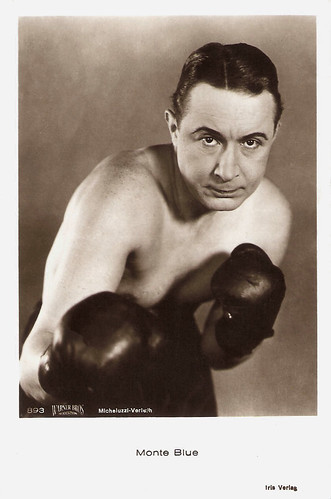
Austrian postcard by Iris Verlag, no. 893. Photo: Warner Bros / Micheluzzi Verleih. Monte Blue in One-Round Hogan (Howard Bretherton, 1927).
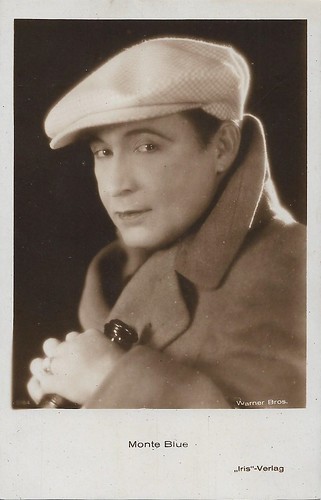
Austrian postcard by Iris Verlag, no. 35a. Photo: Warner Bros.
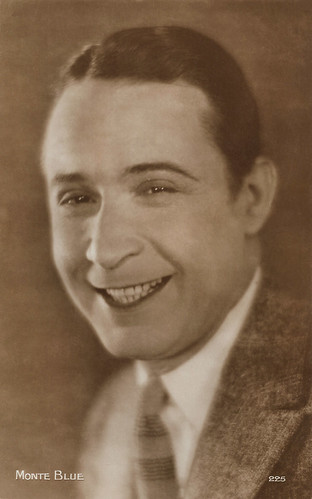
French postcard by Editions Cinémagazine, no. 226.
Stuntman for Houdini
Monte Blue was born Gerard Montgomery Bluefeather in 1887 in Indianapolis, Indiana. His father was half-French and part Cherokee and Osage Indian, a Civil War veteran in the Union army who had once served as a scout for famed frontiersman Buffalo Bill Cody.
His father was killed in a railroad accident when Blue was eight years old. His mother could not raise Monte and her other four children by herself, so Monte and one of his brothers were raised in the Soldiers and Sailors Orphans Home in Knightstown, Indiana. He eventually worked his way through Purdue University in West Lafayette, Indiana.
He played football and worked as a fireman, railroad worker, coal miner, cowpuncher, ranch hand, circus rider, and lumberjack. He started his film career as a stuntman for D.W. Griffith and made his debut as an extra in The Birth of a Nation (1915). Next, he played another small part in Intolerance (D. W. Griffith, 1916).
He also was a stuntman or stand-in for Sir Herbert Beerbohm Tree during the making of Macbeth (John Emerson, 1916). He also appeared in the Harry Houdini film The Grim Game (Irvin Willat, 1919) in which he did stunts in an airplane because Houdini had a fear of flying.
Gradually moving to support roles for both D.W. Griffith and Cecil B. DeMille, Blue earned his breakthrough role as Danton in Griffith's classic Orphans of the Storm (D.W. Griffith, 1921) with Lillian Gish and Dorothy Gish.
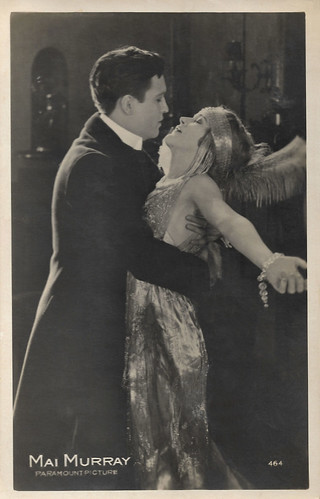
Italian postcard by G. Vettori, Bologna, no. 464. Photo: Ernest Bachrach / Paramount Pictures. Mae Murray and Monte Blue in The Gilded Lily (Robert Z. Leonard, 1921).
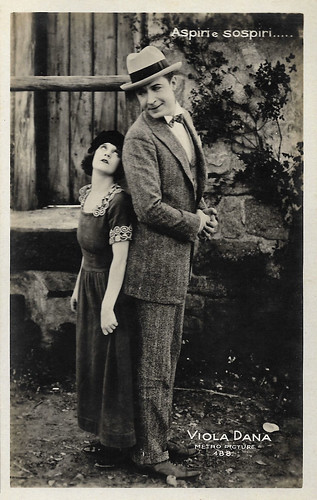
Italian postcard by G. Vettori, Bologna, no. 488. Photo: Metro Picture. Viola Dana and Monte Blue in Revelation (George D. Baker, 1927). The Italian title is Aspiri e sospiri.....

German postcard by Ross Verlag, no. 110/6. Photo: Metro-Goldwyn-Mayer. Monte Blue in White Shadows in the South Seas (W.S. Van Dyke, Robert Flaherty, 1928).
A rugged romantic lead
Monte Blue rose to stardom as a rugged romantic lead opposite Hollywood's top silent stars, among them Gloria Swanson , Clara Bow, and Norma Shearer . He was most often partnered with Marie Prevost , such as in the silent romantic comedy Kiss Me Again (Ernst Lubitsch, 1925).
Blue's finest silent-screen performance was as the alcoholic doctor who finds paradise in White Shadows in the South Seas (W.S. Van Dyke, Robert Flaherty, 1928).
He made a relatively easy transition into talkies as he had a fine, cultivated voice, but, at the same time, lost most of his investments when the stock market crashed in 1929. By the 1930s the aging star had moved back into small, often unbilled parts, continuously employed, however, by his old friend DeMille and Warner Bros.
In the Film Noir Key Largo (John Huston, 1948), Blue was memorable as 'Sheriff Ben Wade' opposite Lionel Barrymore. On TV, he was a recurring guest star in The Lone Ranger (1949-1953). At the end of his life, he was working as an advance man for the Hamid-Morton Circus in Milwaukee.
Monte Blue died of a coronary attack complicated by influenza in 1963. He was married three times. His wives were Erma Gladys (divorce in 1923), Tove Janson (1924-1956; her death) and Betty Jean Munson Mess (1959-1963; his death). With Janson he had two children: Barbara Ann (d. 2008) and Richard Monte (d. 1962).
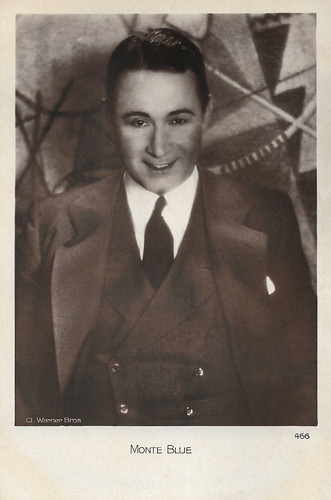
French postcard by Cinémagazine-Edition, Paris, no. 466. Photo: Warner Bros.
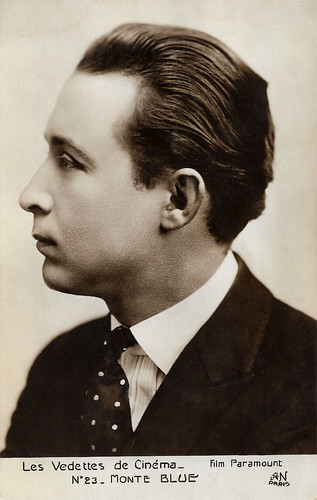
French postcard in the Les Vedettes de Cinéma series by A.N., Paris, no. 23. Photo: Paramount.
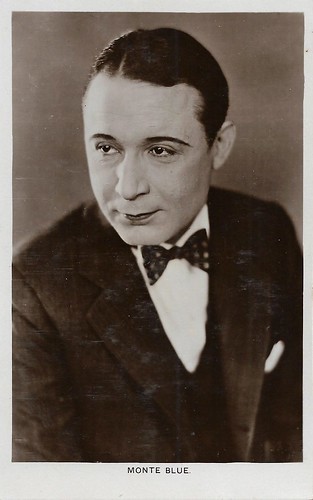
British postcard in the Picturegoer series, London, no. 35a.
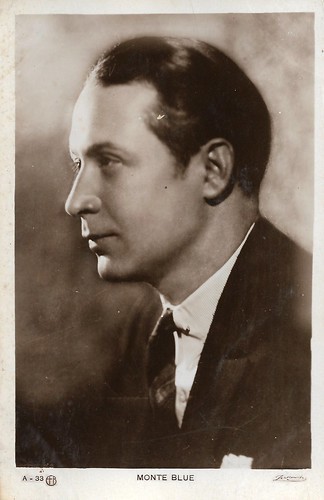
Spanish postcard by EFB (Editorial Fotografica, Barcelona), no. A-33.
Sources: (IMDb), Wikipedia and .

Austrian postcard by Iris Verlag, no. 893. Photo: Warner Bros / Micheluzzi Verleih. Monte Blue in One-Round Hogan (Howard Bretherton, 1927).

Austrian postcard by Iris Verlag, no. 35a. Photo: Warner Bros.

French postcard by Editions Cinémagazine, no. 226.
Stuntman for Houdini
Monte Blue was born Gerard Montgomery Bluefeather in 1887 in Indianapolis, Indiana. His father was half-French and part Cherokee and Osage Indian, a Civil War veteran in the Union army who had once served as a scout for famed frontiersman Buffalo Bill Cody.
His father was killed in a railroad accident when Blue was eight years old. His mother could not raise Monte and her other four children by herself, so Monte and one of his brothers were raised in the Soldiers and Sailors Orphans Home in Knightstown, Indiana. He eventually worked his way through Purdue University in West Lafayette, Indiana.
He played football and worked as a fireman, railroad worker, coal miner, cowpuncher, ranch hand, circus rider, and lumberjack. He started his film career as a stuntman for D.W. Griffith and made his debut as an extra in The Birth of a Nation (1915). Next, he played another small part in Intolerance (D. W. Griffith, 1916).
He also was a stuntman or stand-in for Sir Herbert Beerbohm Tree during the making of Macbeth (John Emerson, 1916). He also appeared in the Harry Houdini film The Grim Game (Irvin Willat, 1919) in which he did stunts in an airplane because Houdini had a fear of flying.
Gradually moving to support roles for both D.W. Griffith and Cecil B. DeMille, Blue earned his breakthrough role as Danton in Griffith's classic Orphans of the Storm (D.W. Griffith, 1921) with Lillian Gish and Dorothy Gish.

Italian postcard by G. Vettori, Bologna, no. 464. Photo: Ernest Bachrach / Paramount Pictures. Mae Murray and Monte Blue in The Gilded Lily (Robert Z. Leonard, 1921).

Italian postcard by G. Vettori, Bologna, no. 488. Photo: Metro Picture. Viola Dana and Monte Blue in Revelation (George D. Baker, 1927). The Italian title is Aspiri e sospiri.....

German postcard by Ross Verlag, no. 110/6. Photo: Metro-Goldwyn-Mayer. Monte Blue in White Shadows in the South Seas (W.S. Van Dyke, Robert Flaherty, 1928).
A rugged romantic lead
Monte Blue rose to stardom as a rugged romantic lead opposite Hollywood's top silent stars, among them Gloria Swanson , Clara Bow, and Norma Shearer . He was most often partnered with Marie Prevost , such as in the silent romantic comedy Kiss Me Again (Ernst Lubitsch, 1925).
Blue's finest silent-screen performance was as the alcoholic doctor who finds paradise in White Shadows in the South Seas (W.S. Van Dyke, Robert Flaherty, 1928).
He made a relatively easy transition into talkies as he had a fine, cultivated voice, but, at the same time, lost most of his investments when the stock market crashed in 1929. By the 1930s the aging star had moved back into small, often unbilled parts, continuously employed, however, by his old friend DeMille and Warner Bros.
In the Film Noir Key Largo (John Huston, 1948), Blue was memorable as 'Sheriff Ben Wade' opposite Lionel Barrymore. On TV, he was a recurring guest star in The Lone Ranger (1949-1953). At the end of his life, he was working as an advance man for the Hamid-Morton Circus in Milwaukee.
Monte Blue died of a coronary attack complicated by influenza in 1963. He was married three times. His wives were Erma Gladys (divorce in 1923), Tove Janson (1924-1956; her death) and Betty Jean Munson Mess (1959-1963; his death). With Janson he had two children: Barbara Ann (d. 2008) and Richard Monte (d. 1962).

French postcard by Cinémagazine-Edition, Paris, no. 466. Photo: Warner Bros.

French postcard in the Les Vedettes de Cinéma series by A.N., Paris, no. 23. Photo: Paramount.

British postcard in the Picturegoer series, London, no. 35a.

Spanish postcard by EFB (Editorial Fotografica, Barcelona), no. A-33.
Sources: (IMDb), Wikipedia and .
Published on April 12, 2020 22:00
Happy Easter with the stars!
Dear friends, we wish you all Happy Easter!
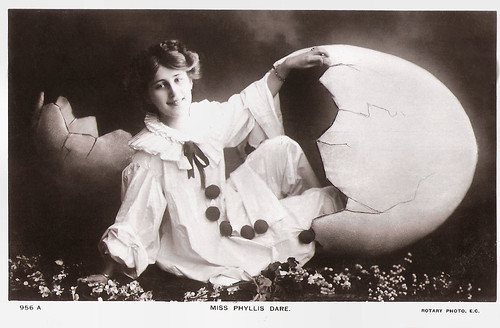
British postcard by Rotary Photo in the Rotary Photographic Series, no. 956 A.
English singer and actress Phyllis Dare (1890-1975) was famous for her performances in Edwardian musical comedy and other forms of musical theatre in the first half of the 20th century. She appeared occasionally in films and was one of the leading Picture Postcard beauties of the Belle Epoque.
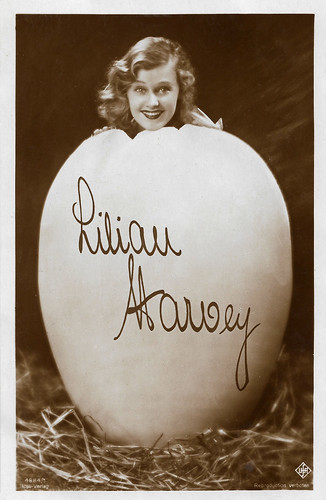
German postcard by Ross Verlag, no. 4884/1, 1929-1930. Photo: Ufa. Collection: Geoffrey Donaldson Institute.
British born, German actress and singer Lilian Harvey (1906-1968) was Ufa's biggest star of the 1930s. With Willy Fritsch , she formed the 'Dream Team of the European Cinema'. Their best film was the immensely popular film operetta Der Kongress tanzt/The Congress Dances (Erik Charell, 1931).
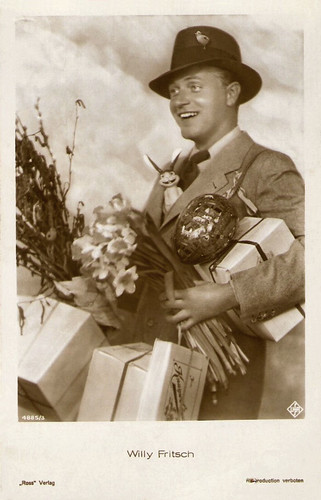
German postcard by Ross Verlag, no. 4885/3, 1929/1930. Photo: Ufa.
Willy Fritsch (1901-1973) was the immensely popular ‘Sunny Boy’ of the Ufa operettas of the 1930s and 1940s.
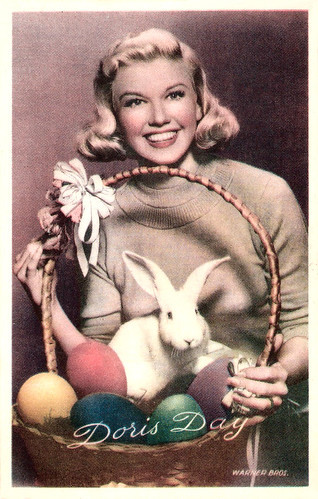
Belgian postcard. Photo: Warner Bros.
Legendary actress and singer Doris Day (1922-2019) performed with several big bands before going solo in 1947. In the 1950s, she made a series of popular film musicals, including Calamity Jane (1953) and The Pajama Game (1957). With Rock Hudson, she starred in the box office hit Pillow Talk (1959), and on TV, she appeared in the sitcom The Doris Day Show (1968-1973). Que Será, Será!
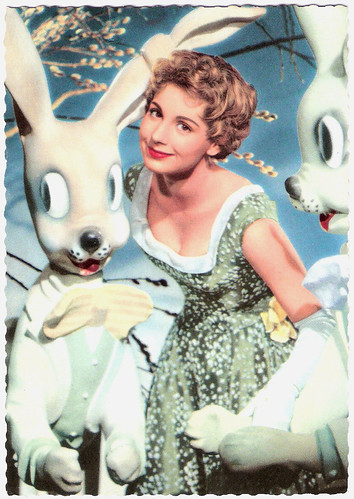
German postcard by Ufa, Berlin-Tempelhof, no. CK-64. Photo: Arthur Grimm / Central Europa Film.
Johanna von Koczian (1933) was in the late 1950s and early 1960s one of Germany’s most popular film stars. Later she evolved into a stage actress, a popular schlager singer, a TV presenter, and a successful author of novels and children books.

British postcard by Rotary Photo in the Rotary Photographic Series, no. 956 A.
English singer and actress Phyllis Dare (1890-1975) was famous for her performances in Edwardian musical comedy and other forms of musical theatre in the first half of the 20th century. She appeared occasionally in films and was one of the leading Picture Postcard beauties of the Belle Epoque.

German postcard by Ross Verlag, no. 4884/1, 1929-1930. Photo: Ufa. Collection: Geoffrey Donaldson Institute.
British born, German actress and singer Lilian Harvey (1906-1968) was Ufa's biggest star of the 1930s. With Willy Fritsch , she formed the 'Dream Team of the European Cinema'. Their best film was the immensely popular film operetta Der Kongress tanzt/The Congress Dances (Erik Charell, 1931).

German postcard by Ross Verlag, no. 4885/3, 1929/1930. Photo: Ufa.
Willy Fritsch (1901-1973) was the immensely popular ‘Sunny Boy’ of the Ufa operettas of the 1930s and 1940s.

Belgian postcard. Photo: Warner Bros.
Legendary actress and singer Doris Day (1922-2019) performed with several big bands before going solo in 1947. In the 1950s, she made a series of popular film musicals, including Calamity Jane (1953) and The Pajama Game (1957). With Rock Hudson, she starred in the box office hit Pillow Talk (1959), and on TV, she appeared in the sitcom The Doris Day Show (1968-1973). Que Será, Será!

German postcard by Ufa, Berlin-Tempelhof, no. CK-64. Photo: Arthur Grimm / Central Europa Film.
Johanna von Koczian (1933) was in the late 1950s and early 1960s one of Germany’s most popular film stars. Later she evolved into a stage actress, a popular schlager singer, a TV presenter, and a successful author of novels and children books.
Published on April 12, 2020 04:08
April 11, 2020
Raquel Torres
Raquel Torres (1908-1987) was a Mexican-born American film actress. She had her breakthrough as a Polynesian beauty in White Shadows in the South Seas (1928). She played island girls, biracial beauties and was a sexy foil to the Marx Brothers in Duck Soup (1933). After marrying a stockbroker in 1935, she retired.
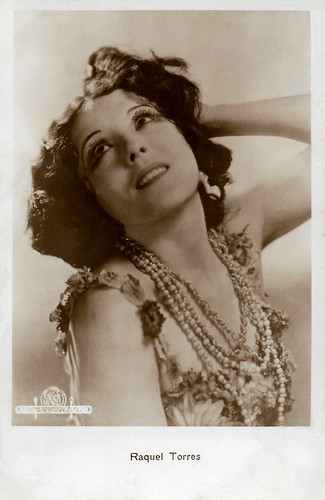
Belgian postcard by P.I.A. Belga Phot., Bruxelles. Photo: Metro-Goldwyn-Mayer.

French postcard by Cinémagazine-Editions, no. 596. Photo: Metro-Goldwyn-Mayer. Raquel Torres in White Shadows in the South Seas (W.S. Van Dyke, Robert Flaherty, 1928).
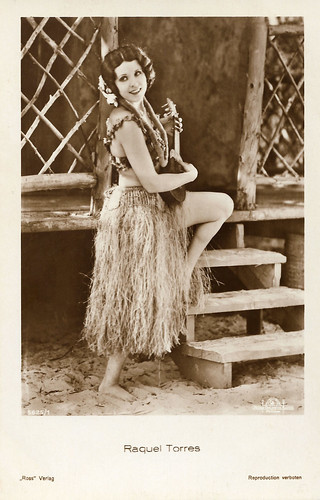
German postcard by Ross Verlag, no. 5625/1, 1930-1931. Photo: Metro-Goldwyn-Mayer. Raquel Torres in Aloha (Albert S. Rogell, 1931).
Early Hollywood's idea of 'Latin-ness'
Raquel Torres was born Paula Marie Osterman or Wilhelmina von Osterman in 1908 in Hermosillo to a German immigrant father and a Mexican mother. Her sister was actress Renee Torres. Her mother died while Raquel was very young and the family moved to the United States, where she spent most of her time.
Her name change, including the adoption of her mother's maiden surname, as well as speaking with a fake accent, was done to capitalise on, and conform to, early Hollywood's idea of 'Latin-ness'.
The 19-years-old Torres played a Polynesian beauty opposite Monte Blue in White Shadows in the South Seas (W.S. Van Dyke, 1928), a silent film shot in Tahiti. It was MGM's first film to synchronise music, dialogue, and sound effects. She gained the role after 300 applicants were rejected. The beautifully shot film went on to win the Best Cinematography Oscar.
The next year she was third-billed behind Lily Damita and Ernest Torrence in The Bridge of San Luis Rey (Charles Brabin, 1929), the first film version of the classic Thornton Wilder novel, which was a part-talkie. This Oscar winner (for Art Direction) was an early disaster movie that bonded a group of strangers who see their lives flash before their eyes while trapped on a collapsing bridge.
Torres' other film that year was The Desert Rider (Nick Grinde, 1929), a standard Western in which she provided spicy diversion opposite cowboy star Tim McCoy.
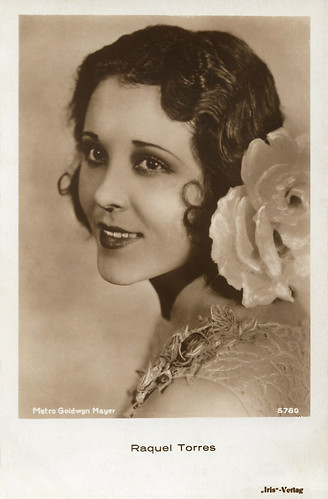
German postcard by Iris Verlag, no. 5780. Photo: Metro-Goldwyn-Mayer.

German postcard by Ross Verlag, no. 110/5. Photo: Metro-Goldwyn-Mayer. Raquel Torres in White Shadows in the South Seas (W.S. Van Dyke, 1928).
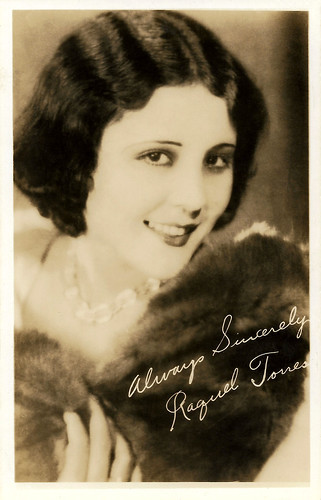
British postcard.
The tropical island pace
Raquel Torres continued the tropical island pace with The Sea Bat (Lionel Barrymore, Wesley Ruggles, 1930) with Charles Bickford and Boris Karloff , and Aloha (Albert S. Rogell, 1931), starring Ben Lyon. Also in 1931, she had a vaudeville act in New York. On Broadway, she played Teresa in 'Adam Had Two Sons' (1932).
The following year, she played a sexy foil to the raucous comedy teams of Bert Wheeler and Robert Woolsey in So This Is Africa (Edward F. Cline, 1933) and the Marx Brothers in Duck Soup (Leo McCarey, 1933). It was Torres to whom Groucho delivered his classic line: "I could dance with you until the cows came home. On second thought, I'd rather dance with the cows until you came home." Duck Soup is now widely considered among critics to be a masterpiece of comedy and the Marx Brothers' finest film.
In 1934 Torres met at a Hollywood party the New York stockbroker Stephen Ames, who once was married to actress Adrienne Ames. Following her marriage to Ames in 1935, Torres abruptly retired. Her final film was the comedy Go West, Young Man (Henry Hathaway, 1936) starring Mae West, Warren William, and Randolph Scott.
Torres and her husband purchased an option on two and a half acres of land in the exclusive Los Angeles enclave of Bel-Air where they wanted to build a home. Her husband later produced postwar B-films including The Spanish Main (Frank Borzage, 1945), but she never returned to the film industry. Ames died in 1955. In 1959, Torres married actor Jon Hall, a hero of the 1930s and 1940s South Sea epics. They divorced in 1967.
In 1985, a fire in Malibu damaged her home, but the actress escaped unharmed, escorted by firefighters to safety. In 1987, Raquel Torres died of complications from an earlier stroke in Malibu, California. She was 78 years old.
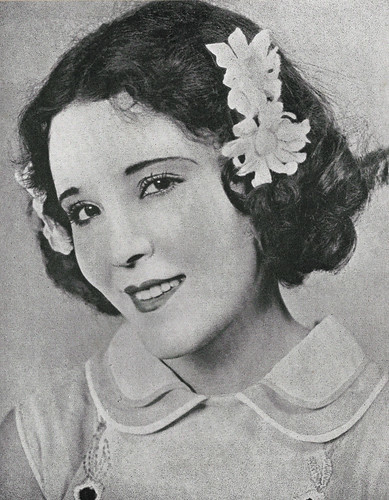
Photo of a Dutch calendar, ca. 1930. We bought the pages at the VerzamelaarsJaarbeurs, The International Collectors Fair in Utrecht. The calendar had been part of the film memorabilia collection of the seller's father.
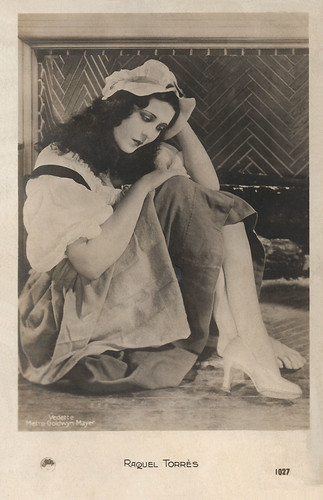
French postcard by Europe, no. 1027. Photo: Metro-Goldwyn-Mayer.
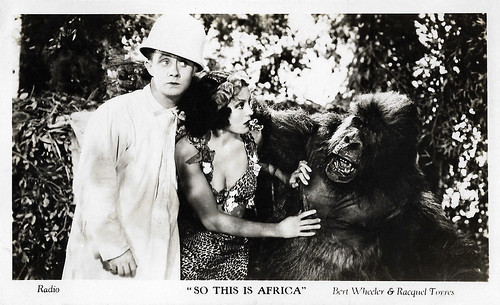
British postcard in the Filmshots series by Film Weekly. Photo: Radio. Bert Wheeler and Raquel Torres in So This Is Africa (Edward F. Cline, 1933).
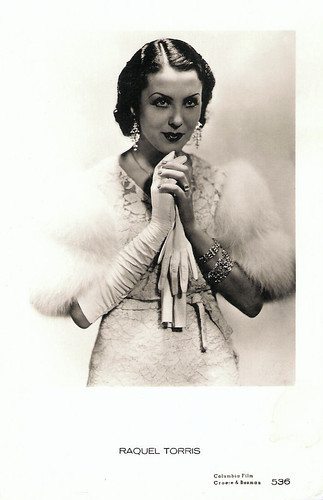
Dutch postcard by Croese & Bosman, no. 536. Photo: Columbia Film. Sent by mail in 1934.
Sources: (IMDb), Wikipedia and .

Belgian postcard by P.I.A. Belga Phot., Bruxelles. Photo: Metro-Goldwyn-Mayer.

French postcard by Cinémagazine-Editions, no. 596. Photo: Metro-Goldwyn-Mayer. Raquel Torres in White Shadows in the South Seas (W.S. Van Dyke, Robert Flaherty, 1928).

German postcard by Ross Verlag, no. 5625/1, 1930-1931. Photo: Metro-Goldwyn-Mayer. Raquel Torres in Aloha (Albert S. Rogell, 1931).
Early Hollywood's idea of 'Latin-ness'
Raquel Torres was born Paula Marie Osterman or Wilhelmina von Osterman in 1908 in Hermosillo to a German immigrant father and a Mexican mother. Her sister was actress Renee Torres. Her mother died while Raquel was very young and the family moved to the United States, where she spent most of her time.
Her name change, including the adoption of her mother's maiden surname, as well as speaking with a fake accent, was done to capitalise on, and conform to, early Hollywood's idea of 'Latin-ness'.
The 19-years-old Torres played a Polynesian beauty opposite Monte Blue in White Shadows in the South Seas (W.S. Van Dyke, 1928), a silent film shot in Tahiti. It was MGM's first film to synchronise music, dialogue, and sound effects. She gained the role after 300 applicants were rejected. The beautifully shot film went on to win the Best Cinematography Oscar.
The next year she was third-billed behind Lily Damita and Ernest Torrence in The Bridge of San Luis Rey (Charles Brabin, 1929), the first film version of the classic Thornton Wilder novel, which was a part-talkie. This Oscar winner (for Art Direction) was an early disaster movie that bonded a group of strangers who see their lives flash before their eyes while trapped on a collapsing bridge.
Torres' other film that year was The Desert Rider (Nick Grinde, 1929), a standard Western in which she provided spicy diversion opposite cowboy star Tim McCoy.

German postcard by Iris Verlag, no. 5780. Photo: Metro-Goldwyn-Mayer.

German postcard by Ross Verlag, no. 110/5. Photo: Metro-Goldwyn-Mayer. Raquel Torres in White Shadows in the South Seas (W.S. Van Dyke, 1928).

British postcard.
The tropical island pace
Raquel Torres continued the tropical island pace with The Sea Bat (Lionel Barrymore, Wesley Ruggles, 1930) with Charles Bickford and Boris Karloff , and Aloha (Albert S. Rogell, 1931), starring Ben Lyon. Also in 1931, she had a vaudeville act in New York. On Broadway, she played Teresa in 'Adam Had Two Sons' (1932).
The following year, she played a sexy foil to the raucous comedy teams of Bert Wheeler and Robert Woolsey in So This Is Africa (Edward F. Cline, 1933) and the Marx Brothers in Duck Soup (Leo McCarey, 1933). It was Torres to whom Groucho delivered his classic line: "I could dance with you until the cows came home. On second thought, I'd rather dance with the cows until you came home." Duck Soup is now widely considered among critics to be a masterpiece of comedy and the Marx Brothers' finest film.
In 1934 Torres met at a Hollywood party the New York stockbroker Stephen Ames, who once was married to actress Adrienne Ames. Following her marriage to Ames in 1935, Torres abruptly retired. Her final film was the comedy Go West, Young Man (Henry Hathaway, 1936) starring Mae West, Warren William, and Randolph Scott.
Torres and her husband purchased an option on two and a half acres of land in the exclusive Los Angeles enclave of Bel-Air where they wanted to build a home. Her husband later produced postwar B-films including The Spanish Main (Frank Borzage, 1945), but she never returned to the film industry. Ames died in 1955. In 1959, Torres married actor Jon Hall, a hero of the 1930s and 1940s South Sea epics. They divorced in 1967.
In 1985, a fire in Malibu damaged her home, but the actress escaped unharmed, escorted by firefighters to safety. In 1987, Raquel Torres died of complications from an earlier stroke in Malibu, California. She was 78 years old.

Photo of a Dutch calendar, ca. 1930. We bought the pages at the VerzamelaarsJaarbeurs, The International Collectors Fair in Utrecht. The calendar had been part of the film memorabilia collection of the seller's father.

French postcard by Europe, no. 1027. Photo: Metro-Goldwyn-Mayer.

British postcard in the Filmshots series by Film Weekly. Photo: Radio. Bert Wheeler and Raquel Torres in So This Is Africa (Edward F. Cline, 1933).

Dutch postcard by Croese & Bosman, no. 536. Photo: Columbia Film. Sent by mail in 1934.
Sources: (IMDb), Wikipedia and .
Published on April 11, 2020 22:00
April 10, 2020
New acquisitions: American leading ladies of the early silent cinema
Lately, we acquired this series of 11 American postcards with painted portraits of early silent film actresses. The series was published by the Kline Poster Co. Inc. of Philadelphia and must have been produced around 1915. The actresses worked for such American studios as Essanay, Pallas, Metro, Fox and Lasky, and they were among America's first film stars. Most of these leading ladies are forgotten now and many of their films are lost. Only, Fannie Ward is known for Cecil B. De Mille's The Cheat (1915) and Ethel Barrymore is still remembered for her films of the 1940s or 1950s. When we uploaded her card at Flickr, Philip Mayer commented: "The rumours were true, then. She was young, once."
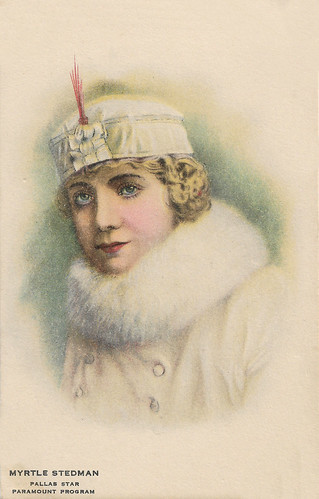
American postcard by Kline Poster Co. Inc., Phila. Image: Pallas / Paramount.
American silent screen actress Myrtle Stedman (1885-1938) was known as 'the girl with the pearly eyes'. In 1911, Myrtle and husband Marshall Stedman were signed by the Selig Polyscope Co. Myrtle was a leading lady in silent films of the 1910s and early 1920s for such companies as Bosworth and Pallas and later, she became a character actress.
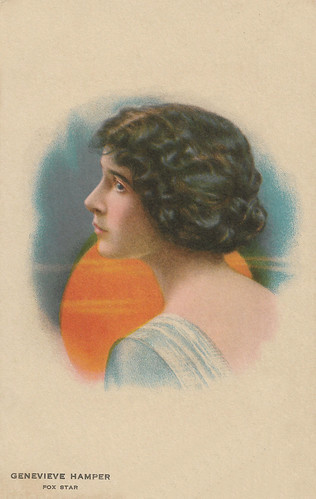
American postcard by Kline Poster Co. Inc., Phila. Image: Fox.
Genevieve Hamper (1888-1971) was an American stage actress who also starred in seven silent films. She often appeared on stage and in early silent films with her much older husband Robert B. Mantell.
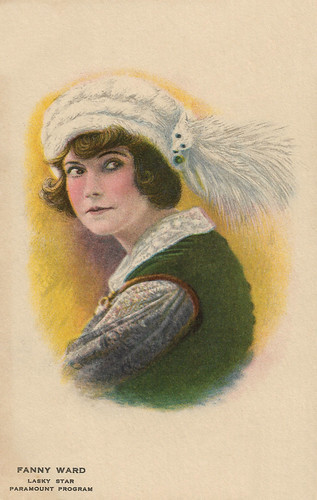
American postcard by Kline Poster Co. Inc., Phila. Image: Lasky / Paramount.
Fannie Ward, a.k.a. Fanny Ward (1871–1952) was a star of light comedies on Broadway and in vaudeville. Internationally famous, she was at the height of her career in the first decade of the 20th century. Later she was known for The Cheat (1915), a sexually- and racially-charged silent film directed by Cecil B. DeMille. In the late 1910s she did a series of films for Astra Films, released by Pathé Exchange.
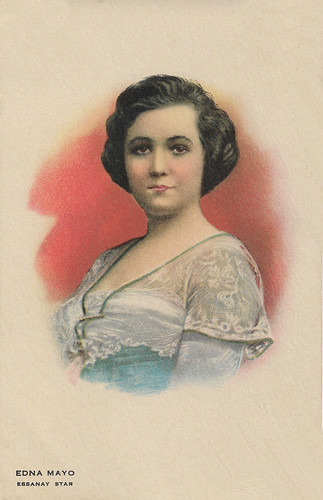
American postcard by Kline Poster Co. Inc., Phila. Image: Essanay.
Edna Mayo (1895-1970) was an American actress of the silent film era. She was on stage from 1906 and prominent in films with Essanay between 1914 and 1918.
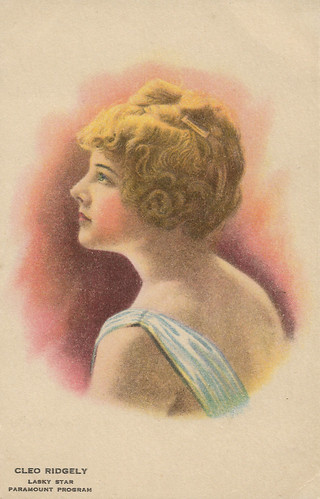
American postcard by Kline Poster Co. Inc., Phila. Image: Lasky / Paramount.
Cleo Ridgely (1893-1962) was a New York chorus girl, who became a modern, sporty silent screen lady of the 1910s. In a Kalem series of shorts, she starred as Jean, the Girl Detective.
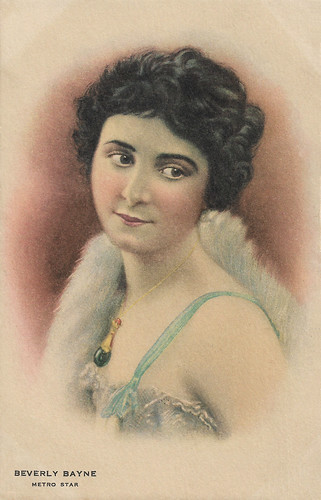
American postcard by Kline Poster Co. Inc., Phila. Image: Metro.
Wide-eyed, brunette Beverly Bayne (1894-1982) was an American silent film actress who began her career in 1910 at the Essanay Studios in Chicago. With Francis X. Bushman, she formed the most successful romantic couple of the early cinema. They appeared together in 24 films.
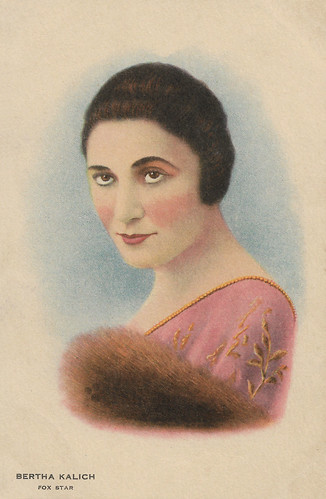
American postcard by Kline Poster Co. Inc., Phila. Image: Fox.
Austrian born, American actress Bertha Kalich (1874-1939) was known for her majestic bearing, great beauty, and fine diction. She started her career as an entertainer in Eastern Europe. During the late nineteenth and early twentieth century, she became one of the 'larger-than-life' figures that dominated New York stages during the Golden Age' of American Yiddish Theatre. Kalich was the first female actor to make the transition from the Yiddish to the English stage. During the 1910s she became one of the stars of Fox Film.
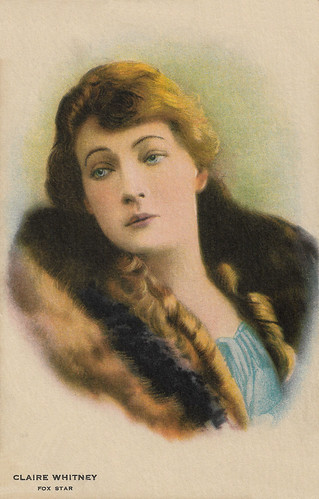
American postcard by Kline Poster Co. Inc., Phila. Image: Fox.
Claire Whitney (1890-1969) was an American stage and film actress who appeared between 1912 and 1949 in 111 films for companies like Solax and later Fox. Only 21 of these films survive, as most have been lost.
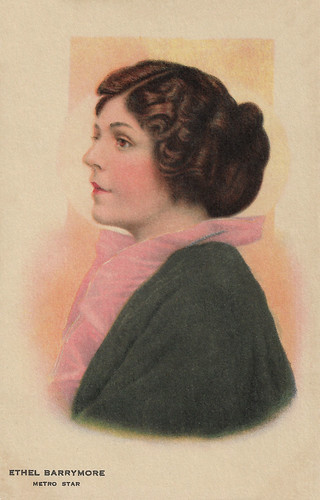
American postcard by Kline Poster Co. Inc., Phila. Image: Metro.
American actress Ethel Barrymore (1879-1959) was a member of the Barrymore family of actors. Her career as a stage, screen and radio actress spanned six decades, and she was regarded as "The First Lady of the American Theatre". She made 15 silent pictures between 1914 and 1919, most of them for the Metro Pictures studio.
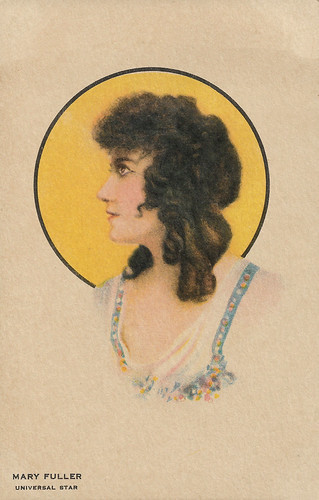
American postcard by Kline Poster Co. Inc., Phila. Image: Universal.
American actress Mary Filler (1988-1973) started her film career at Vitagraph and had her breakthrough at Edison. At Universal, Fuller became a major early film star who rivalled Mary Pickford in popularity. In 1917, she left the film industry and ended her life in a mental hospital.
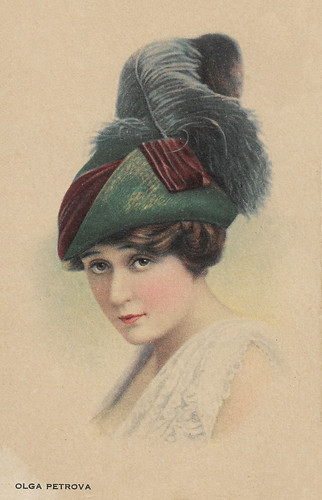
American postcard by Kline Poster Co. Inc., Phila.
Olga Petrova (1884-1977) was a British-American actress, screenwriter and playwright. During her seven years in film, Petrova appeared in more than two dozen films and wrote the script for several others.
If you like to read more background info about the actresses, double click on the postcards or read their bios in our Flickr album on the Kline Poster Co.

American postcard by Kline Poster Co. Inc., Phila. Image: Pallas / Paramount.
American silent screen actress Myrtle Stedman (1885-1938) was known as 'the girl with the pearly eyes'. In 1911, Myrtle and husband Marshall Stedman were signed by the Selig Polyscope Co. Myrtle was a leading lady in silent films of the 1910s and early 1920s for such companies as Bosworth and Pallas and later, she became a character actress.

American postcard by Kline Poster Co. Inc., Phila. Image: Fox.
Genevieve Hamper (1888-1971) was an American stage actress who also starred in seven silent films. She often appeared on stage and in early silent films with her much older husband Robert B. Mantell.

American postcard by Kline Poster Co. Inc., Phila. Image: Lasky / Paramount.
Fannie Ward, a.k.a. Fanny Ward (1871–1952) was a star of light comedies on Broadway and in vaudeville. Internationally famous, she was at the height of her career in the first decade of the 20th century. Later she was known for The Cheat (1915), a sexually- and racially-charged silent film directed by Cecil B. DeMille. In the late 1910s she did a series of films for Astra Films, released by Pathé Exchange.

American postcard by Kline Poster Co. Inc., Phila. Image: Essanay.
Edna Mayo (1895-1970) was an American actress of the silent film era. She was on stage from 1906 and prominent in films with Essanay between 1914 and 1918.

American postcard by Kline Poster Co. Inc., Phila. Image: Lasky / Paramount.
Cleo Ridgely (1893-1962) was a New York chorus girl, who became a modern, sporty silent screen lady of the 1910s. In a Kalem series of shorts, she starred as Jean, the Girl Detective.

American postcard by Kline Poster Co. Inc., Phila. Image: Metro.
Wide-eyed, brunette Beverly Bayne (1894-1982) was an American silent film actress who began her career in 1910 at the Essanay Studios in Chicago. With Francis X. Bushman, she formed the most successful romantic couple of the early cinema. They appeared together in 24 films.

American postcard by Kline Poster Co. Inc., Phila. Image: Fox.
Austrian born, American actress Bertha Kalich (1874-1939) was known for her majestic bearing, great beauty, and fine diction. She started her career as an entertainer in Eastern Europe. During the late nineteenth and early twentieth century, she became one of the 'larger-than-life' figures that dominated New York stages during the Golden Age' of American Yiddish Theatre. Kalich was the first female actor to make the transition from the Yiddish to the English stage. During the 1910s she became one of the stars of Fox Film.

American postcard by Kline Poster Co. Inc., Phila. Image: Fox.
Claire Whitney (1890-1969) was an American stage and film actress who appeared between 1912 and 1949 in 111 films for companies like Solax and later Fox. Only 21 of these films survive, as most have been lost.

American postcard by Kline Poster Co. Inc., Phila. Image: Metro.
American actress Ethel Barrymore (1879-1959) was a member of the Barrymore family of actors. Her career as a stage, screen and radio actress spanned six decades, and she was regarded as "The First Lady of the American Theatre". She made 15 silent pictures between 1914 and 1919, most of them for the Metro Pictures studio.

American postcard by Kline Poster Co. Inc., Phila. Image: Universal.
American actress Mary Filler (1988-1973) started her film career at Vitagraph and had her breakthrough at Edison. At Universal, Fuller became a major early film star who rivalled Mary Pickford in popularity. In 1917, she left the film industry and ended her life in a mental hospital.

American postcard by Kline Poster Co. Inc., Phila.
Olga Petrova (1884-1977) was a British-American actress, screenwriter and playwright. During her seven years in film, Petrova appeared in more than two dozen films and wrote the script for several others.
If you like to read more background info about the actresses, double click on the postcards or read their bios in our Flickr album on the Kline Poster Co.
Published on April 10, 2020 22:00
April 9, 2020
Mariella Lotti
Blonde Italian film actress Mariella Lotti (1921–2006) played leading ladies in a number of Fascist-era and post-war films. The refined beauty quickly became one of the most popular Italian divas of the 1940s.
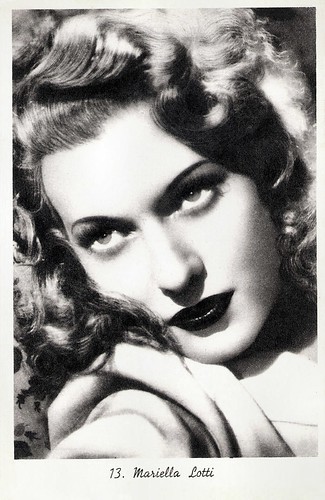
Italian postcard, no. 13.
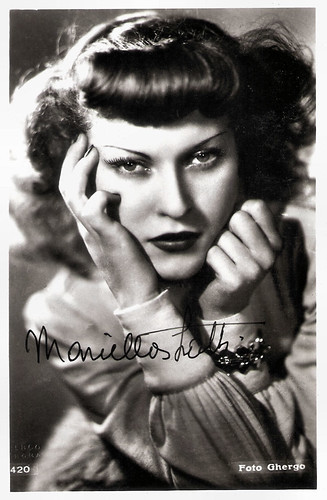
Italian postcard by A. Terzoli, Roma, no. 420. Photo: Ghergo.
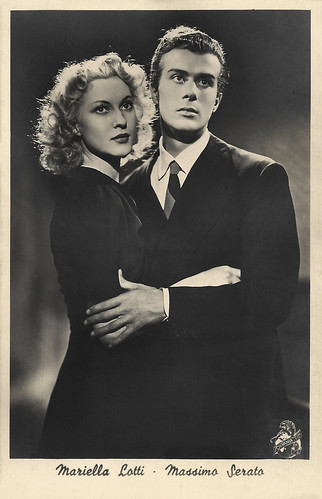
Italian postcard by Alterocca, Terni, no. 6616. Photo: Ferri. Mariella Lotti and Massimo Serato in L'Ispettore Vargas/Inspector Vargas (Gianni Franciolini, Félix Aguilera, 1940).
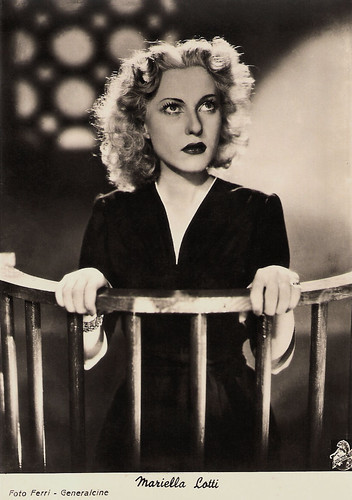
Italian postcard by Alterocca, Terni, no. 6619. Photo: Ferri / Generalcine. Publicity still for Il fiore sotto gli occhi/The flower under the eyes (Guido Brignone, 1944).
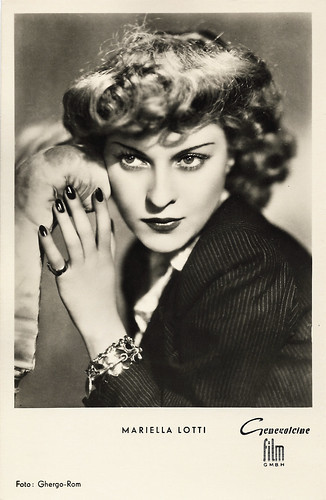
German postcard by Kunst und Bild, Berlin, no. A 570. Photo: Ghergo, Rome / Generalcine Film. Mariella Lotti in La donna che inventò l'amore/The Woman Who Invented Love (Ferruccio Cerio, 1952).
The Ten Commandments
Mariella Lotti was born Maria Camilla Pianotti in 1919 in Busto Arsizio, Lombardy, Italy (on 17 November 1919 according to her baptism certificate or on 18 November 1919 according to her birth certificate) Her sister Carola Lotti later also would be an actress.
In 1939, Mariella made her film debut with a small part in the comedy I figli del marchese Lucera/The sons of the Marquis Lucera (Amleto Palermi, 1939) with Armando Falconi . The following year, she played an important part in the adventure film La figlia del corsaro verde/The Daughter of the Green Pirate (Enrico Guazzoni, 1940), starring Doris Duranti , Fosco Giachetti and Camillo Pilotto .
She also played a supporting part in Il signore della tavern/The tavern ladies (Amleto Palermi, 1940). That year she also appeared in the dramas Kean (Guido Brignone, 1940) with Rossano Brazzi , and Il ponte dei sospiri/The Bridge of Sighs (Mario Bonnard, 1940) with Paola Barbara .
Two years later Lotti appeared in the drama Fari nella nebbia/Headlights in the Fog (Gianni Franciolini, 1942) starring Fosco Giachetti, Luisa Ferida and Antonio Centa . The film follows the lives of a group of truck drivers. It is considered to be part of the development of Neorealism, which emerged around this time.
Lotti then played the title role in the historical adventure film La Gorgona/The Gorgon (Guido Brignone, 1942) about the young daughter of a heroically killed nobleman in 11th Century Pisa who - as the figurehead virgin - will maintain a lantern to celebrate the men's victorious return after driving out the Saracens who are infesting the Mediterranean.
Other films of the fascist era include Quelli della montagna/Those of the Mountain (Aldo Vergano, 1943) with Amedeo Nazzari , the Opera film Silenzio, si gira!/Silence, film recording! (Carlo Campogalliani, 1943) starring Beniamino Gigli , and the war drama Squadriglia bianca (Ion Sava, 1944) with Claudio Gora.
Lotti was one of the many actors employed on the anthology film I dieci comandamenti/The Ten Commandments (Giorgio Walter Chili, 1946), made following the overthrow of Benito Mussolini. The film was shot in Rome in 1944-1945 during the Republic of Salò (when the country occupied by the Germans). At that time, all cinematic activity was transferred to Venice but many actors and technicians refused to go. This film was specifically produced to provide work for all those who decided to stay in Rome. All personnel for the film was able to obtain a work permit from the Vatican as the film, which was based on the classic Bible story, was produced by PROFIR, a Catholic production house closely linked with the catholic church. The film is now considered lost.
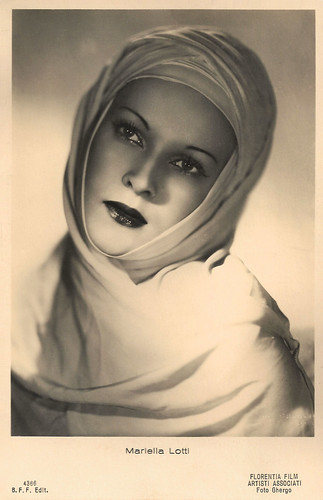
Italian postcard by B.F.F. Edit. (Casa Editr. Ballerini & Fratini, Firenze), no. 4365. Photo: Ghergo / Florentia Film Artisti Associati. Mariella Lotti in La Gorgona/The Gorgon (Guido Brignone, 1942).
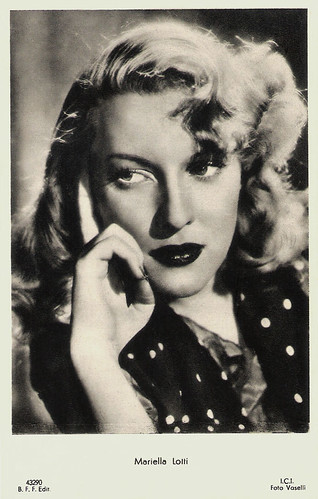
Italian postcard by B.F.F. Edit, no. 43290. Photo: I.C.I. / Vaselli. Publicity still for Fari nella nebbia/Headlights in the fog (Gianni Franciolini, 1942).
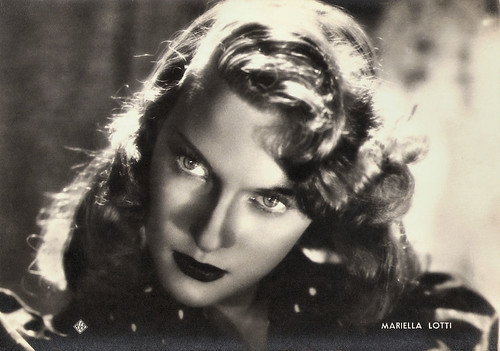
Italian postcard by A. Scarmiglia Ed., Roma (ASER), no. 122. Photo: Fauno Film / Vaselli. Publicity still for Fari nella nebbia/Headlights in the fog (Gianni Franciolini, 1941).
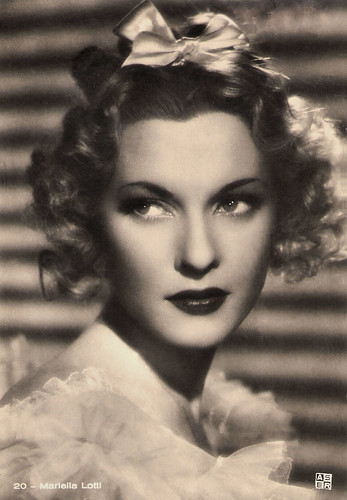
Italian postcard by ASER, no. 20. Sent by mail in 1942.
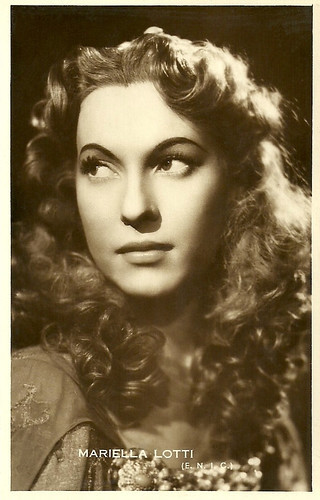
Italian postcard by ENIC.
Pink Neorealism
In 1946, Mariella Lotti played a nun in the Neorealist war film Un giorno nella vita/A Day in Life (Alessandro Blasetti, 1946), about a group of partisans seeking refuge in a cloistered convent. The film was entered into the 1946 Cannes Film Festival.
She also played the female lead opposite Otello Toso and Amedeo Nazzari in the drama Malacarne/For the Love of Mariastella (1946), written and directed by Pino Mercanti. Based on a story of the Sicilian writer Giuseppe Zucca, it was mainly shot in the tonnara (tuna fisher village) of Castellammare del Golfo, with some scenes shot in the tonnaras of Scopello and of San Vito Lo Capo. It is considered as a progenitor of Pink Neorealism, the lighter genre which followed Neorealism when Italy’s conditions approved.
Lotti then co-starred with Fosco Giachetti and Andrea Checchi in the drama I fratelli Karamazoff/The Brothers Karamazov (Giacomo Gentilomo, 1947), based on the novel with the same title by Fyodor Dostoyevsky. It won two Nastro d'Argento Awards, for best screenplay and for the best score. She also starred in the historical drama Guarany (Riccardo Freda, 1948) with Antonio Vilar and Gianna Maria Canale , the Italian/American Swashbuckler I pirati di Capri/The Pirates of Capri (Edgar G. Ulmer, 1949) starring Louis Hayward, and opposite Jean Gabin in the drama È più facile che un cammello.../His Last Twelve Hours (Luigi Zampa, 1951).
In the following years, her parts became smaller. She played a supporting part in the drama Processo alla città/The City Stands Trial (Luigi Zampa, 1952) with Amedeo Nazzari . The film is based on a revisiting of the Cuocolo murders and the struggle for control of Naples by the Camorra in the early 1900s. It is considered to be director Luigi Zampa's most accomplished film and was entered into the 3rd Berlin International Film Festival.
Her final film was the Spanish-Italian drama Carmen proibita/Siempre Carmen (Giuseppe Maria Scotese, 1953) featuring Ana Esmeralda. She also acted in the theatre and worked on two stage productions with Luchino Visconti. Mariella Lotti was married to the industrialist Alfredo Zanardo. Earlier she had a well-publicised affair with Michael, Prince of Romania.
Mariella Lotti passed away in 2004 in Neuilly-Sur-Seine, France. In 2019, her hometown has celebrated the 100th anniversary of her birth and two of her grandchildren attended the event.
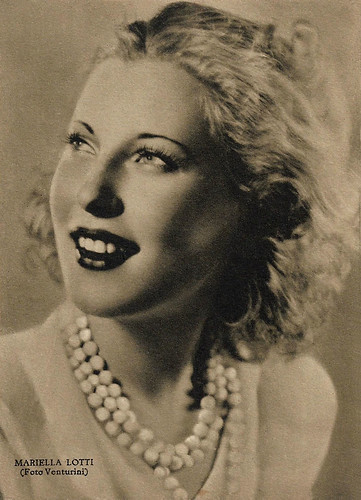
Italian postcard by Rizzoli, 1941. Photo: Venturini.
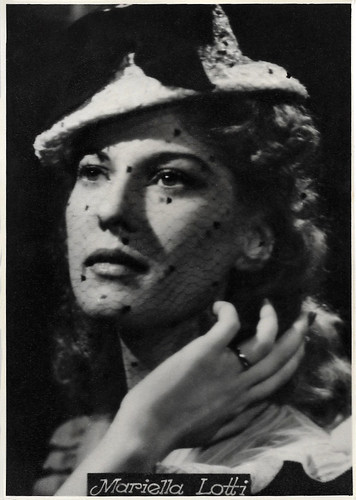
Italian postcard by Mimosa.
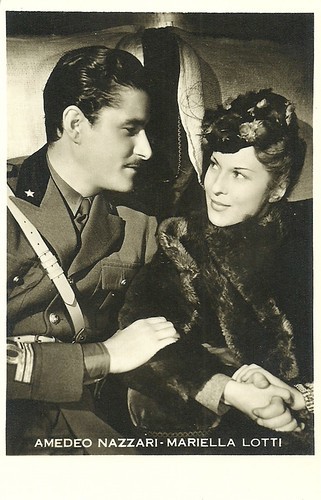
Romanian postcard. Amedeo Nazzari and Mariella Lotti in Quelli della montagna/Those of the Mountain (Aldo Vergano, 1943), supervised by Alessandro Blasetti.
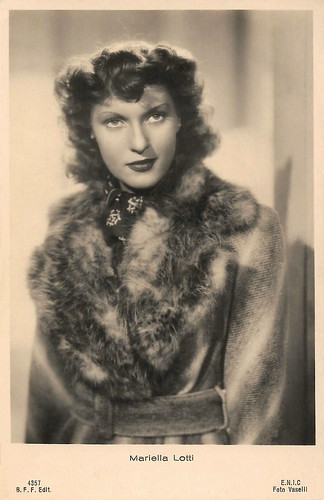
Italian postcard by B.F.F. Edit. (Ballerini & Fratini Editori, Firenze), no. 4357. Photo: Vaselli / E.N.I.C.
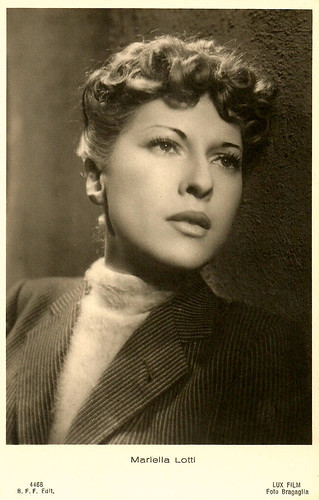
Italian postcard by B.F.F. Edit. (Ballerini & Fratini Editori, Firenze), no. 4468. Photo: Bragalia / Lux Film.
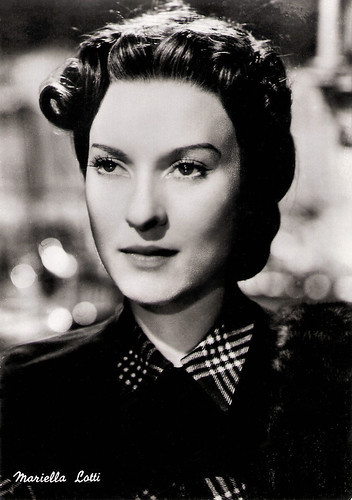
Italian postcard by Rotalfoto, Milano / Ediz. Garami, no. 143.
Sources: Marlene Pilaete (La Collectionneuse - French), Wikipedia (Italian and English) and .

Italian postcard, no. 13.

Italian postcard by A. Terzoli, Roma, no. 420. Photo: Ghergo.

Italian postcard by Alterocca, Terni, no. 6616. Photo: Ferri. Mariella Lotti and Massimo Serato in L'Ispettore Vargas/Inspector Vargas (Gianni Franciolini, Félix Aguilera, 1940).

Italian postcard by Alterocca, Terni, no. 6619. Photo: Ferri / Generalcine. Publicity still for Il fiore sotto gli occhi/The flower under the eyes (Guido Brignone, 1944).

German postcard by Kunst und Bild, Berlin, no. A 570. Photo: Ghergo, Rome / Generalcine Film. Mariella Lotti in La donna che inventò l'amore/The Woman Who Invented Love (Ferruccio Cerio, 1952).
The Ten Commandments
Mariella Lotti was born Maria Camilla Pianotti in 1919 in Busto Arsizio, Lombardy, Italy (on 17 November 1919 according to her baptism certificate or on 18 November 1919 according to her birth certificate) Her sister Carola Lotti later also would be an actress.
In 1939, Mariella made her film debut with a small part in the comedy I figli del marchese Lucera/The sons of the Marquis Lucera (Amleto Palermi, 1939) with Armando Falconi . The following year, she played an important part in the adventure film La figlia del corsaro verde/The Daughter of the Green Pirate (Enrico Guazzoni, 1940), starring Doris Duranti , Fosco Giachetti and Camillo Pilotto .
She also played a supporting part in Il signore della tavern/The tavern ladies (Amleto Palermi, 1940). That year she also appeared in the dramas Kean (Guido Brignone, 1940) with Rossano Brazzi , and Il ponte dei sospiri/The Bridge of Sighs (Mario Bonnard, 1940) with Paola Barbara .
Two years later Lotti appeared in the drama Fari nella nebbia/Headlights in the Fog (Gianni Franciolini, 1942) starring Fosco Giachetti, Luisa Ferida and Antonio Centa . The film follows the lives of a group of truck drivers. It is considered to be part of the development of Neorealism, which emerged around this time.
Lotti then played the title role in the historical adventure film La Gorgona/The Gorgon (Guido Brignone, 1942) about the young daughter of a heroically killed nobleman in 11th Century Pisa who - as the figurehead virgin - will maintain a lantern to celebrate the men's victorious return after driving out the Saracens who are infesting the Mediterranean.
Other films of the fascist era include Quelli della montagna/Those of the Mountain (Aldo Vergano, 1943) with Amedeo Nazzari , the Opera film Silenzio, si gira!/Silence, film recording! (Carlo Campogalliani, 1943) starring Beniamino Gigli , and the war drama Squadriglia bianca (Ion Sava, 1944) with Claudio Gora.
Lotti was one of the many actors employed on the anthology film I dieci comandamenti/The Ten Commandments (Giorgio Walter Chili, 1946), made following the overthrow of Benito Mussolini. The film was shot in Rome in 1944-1945 during the Republic of Salò (when the country occupied by the Germans). At that time, all cinematic activity was transferred to Venice but many actors and technicians refused to go. This film was specifically produced to provide work for all those who decided to stay in Rome. All personnel for the film was able to obtain a work permit from the Vatican as the film, which was based on the classic Bible story, was produced by PROFIR, a Catholic production house closely linked with the catholic church. The film is now considered lost.

Italian postcard by B.F.F. Edit. (Casa Editr. Ballerini & Fratini, Firenze), no. 4365. Photo: Ghergo / Florentia Film Artisti Associati. Mariella Lotti in La Gorgona/The Gorgon (Guido Brignone, 1942).

Italian postcard by B.F.F. Edit, no. 43290. Photo: I.C.I. / Vaselli. Publicity still for Fari nella nebbia/Headlights in the fog (Gianni Franciolini, 1942).

Italian postcard by A. Scarmiglia Ed., Roma (ASER), no. 122. Photo: Fauno Film / Vaselli. Publicity still for Fari nella nebbia/Headlights in the fog (Gianni Franciolini, 1941).

Italian postcard by ASER, no. 20. Sent by mail in 1942.

Italian postcard by ENIC.
Pink Neorealism
In 1946, Mariella Lotti played a nun in the Neorealist war film Un giorno nella vita/A Day in Life (Alessandro Blasetti, 1946), about a group of partisans seeking refuge in a cloistered convent. The film was entered into the 1946 Cannes Film Festival.
She also played the female lead opposite Otello Toso and Amedeo Nazzari in the drama Malacarne/For the Love of Mariastella (1946), written and directed by Pino Mercanti. Based on a story of the Sicilian writer Giuseppe Zucca, it was mainly shot in the tonnara (tuna fisher village) of Castellammare del Golfo, with some scenes shot in the tonnaras of Scopello and of San Vito Lo Capo. It is considered as a progenitor of Pink Neorealism, the lighter genre which followed Neorealism when Italy’s conditions approved.
Lotti then co-starred with Fosco Giachetti and Andrea Checchi in the drama I fratelli Karamazoff/The Brothers Karamazov (Giacomo Gentilomo, 1947), based on the novel with the same title by Fyodor Dostoyevsky. It won two Nastro d'Argento Awards, for best screenplay and for the best score. She also starred in the historical drama Guarany (Riccardo Freda, 1948) with Antonio Vilar and Gianna Maria Canale , the Italian/American Swashbuckler I pirati di Capri/The Pirates of Capri (Edgar G. Ulmer, 1949) starring Louis Hayward, and opposite Jean Gabin in the drama È più facile che un cammello.../His Last Twelve Hours (Luigi Zampa, 1951).
In the following years, her parts became smaller. She played a supporting part in the drama Processo alla città/The City Stands Trial (Luigi Zampa, 1952) with Amedeo Nazzari . The film is based on a revisiting of the Cuocolo murders and the struggle for control of Naples by the Camorra in the early 1900s. It is considered to be director Luigi Zampa's most accomplished film and was entered into the 3rd Berlin International Film Festival.
Her final film was the Spanish-Italian drama Carmen proibita/Siempre Carmen (Giuseppe Maria Scotese, 1953) featuring Ana Esmeralda. She also acted in the theatre and worked on two stage productions with Luchino Visconti. Mariella Lotti was married to the industrialist Alfredo Zanardo. Earlier she had a well-publicised affair with Michael, Prince of Romania.
Mariella Lotti passed away in 2004 in Neuilly-Sur-Seine, France. In 2019, her hometown has celebrated the 100th anniversary of her birth and two of her grandchildren attended the event.

Italian postcard by Rizzoli, 1941. Photo: Venturini.

Italian postcard by Mimosa.

Romanian postcard. Amedeo Nazzari and Mariella Lotti in Quelli della montagna/Those of the Mountain (Aldo Vergano, 1943), supervised by Alessandro Blasetti.

Italian postcard by B.F.F. Edit. (Ballerini & Fratini Editori, Firenze), no. 4357. Photo: Vaselli / E.N.I.C.

Italian postcard by B.F.F. Edit. (Ballerini & Fratini Editori, Firenze), no. 4468. Photo: Bragalia / Lux Film.

Italian postcard by Rotalfoto, Milano / Ediz. Garami, no. 143.
Sources: Marlene Pilaete (La Collectionneuse - French), Wikipedia (Italian and English) and .
Published on April 09, 2020 22:00
April 8, 2020
Colonna Romano
French stage actress (Gabrielle) Colonna Romano (1883-1981) was a pupil of Sarah Bernhardt and a famous tragedienne of the Comédie-Française from 1913 till 1936. She also appeared in Film d'Art shorts and other early silent films. Her love life was tempestuous and legendary.
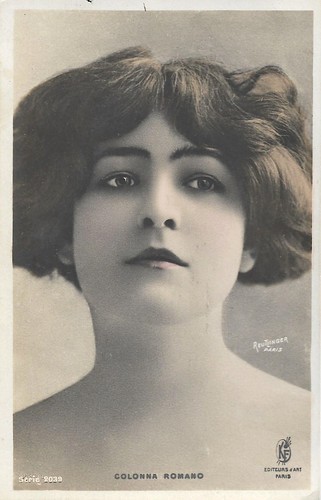
French postcard by KF Editeurs d'art Paris, series 2039. Photo: Reutlinger, Paris.
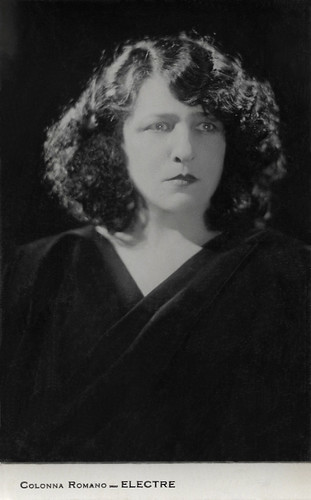
French postcard. Colonna Romano in the play 'Electre' (Electra) by Euripides.
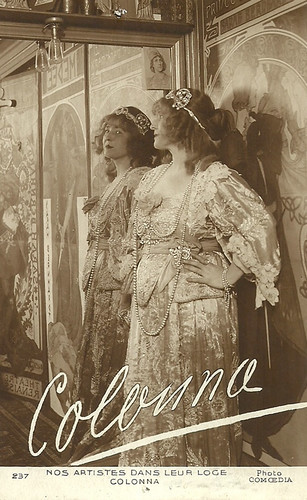
French postcard in the Nos artistes dans leur loge series, no. 237. Photo: Comoedia.
A favourite model of Renoir
Gabrielle Colonna-Romano aka Colonna or Colonna Romano was born Gabrielle Dreyfuss in Paris in 1883. Wikipedia writes that she used Colonna Romano as a film actress, but on most of the cards in this post (including the one above for a stage role and others from the period before her film career), she was called 'Colonna Romano'.
She was a pupil and devotee of Sarah Bernhardt . In 1913, Colonna Romano became a member of the Comédie-Française and was a sociétaire between 1926 and 1936, when she left the Comédie-Française.
Colonna Romano was famous for her roles as tragediénne, such as in the Euripides play 'Electre' (Electra), and she also gave numerous poetry readings, notably by the Symbolist poet Saint-Pol-Roux.
She was also a favourite model of the Impressionist painter Auguste Renoir and posed for such paintings as 'Jeune femme à la rose' (1913). She had an affair with his son Pierre Renoir until he left her for the actress Vera Sergine .
Colonna-Romano also acted in silent films. Between 1908 and 1913 she appeared in Film d'Art shorts such as Hamlet (Henri Desfontaines, 1908), in which she played Queen Gertrude.
She also acted in modern drama and action films, like Hop-Frog (Henri Desfontaines, 1910), L'Honneur/Legion of Honor (Albert Capellani, 1910) with her then-husband George Grand, Le Scarabée d'or/The Gold-Bug (Henri Desfontaines, 1910), and Antar (N.N., 1912).
IMDb and Wikipedia state that her film L'Honneur dates from 1913 and was made by Henri Pouctal. The mostly more reliable Seydoux-Pathé site gives another name and date, which we use above.
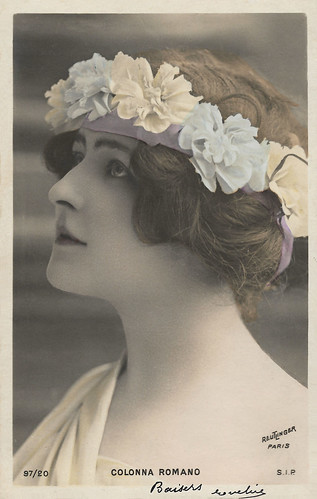
French postcard by. S.I.P., no. 97/20.
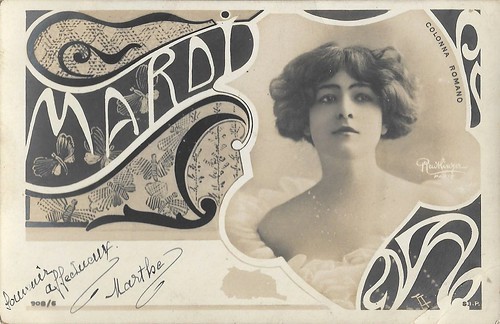
French postcard by S.I.P., no. 908/6. Photo: Reutlinger, Paris. Caption: Mardi (Tuesday).
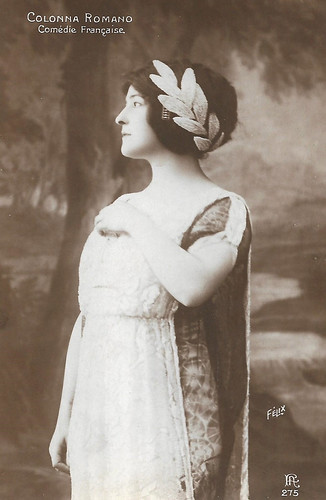
French postcard by FA, no. 275. Photo: Félix. Caption: Colonna Romano, Comédie Française.
Nurse in WWI and resistance fighter in WWII
During the First World War, Colonna Romano was a nurse, according to IMDb .
In England, she met and became friends with Marie Bell who, on her advice, decided to go to the Conservatory.
Romano was married to actor Georges Grand, who died in 1921 of a heart attack at the age of 56. In 1916, while married, she had a relationship with the very young, future filmmaker René Clair, but his best friend Jacques Rigaut was jealous and Romano very free in her relationships... The deluded Clair left for the Red-Cross in 1917.
She was the sixth and final wife of the millionaire press-magnate Alfred Edwards, and after his death, she married in 1939 the actor Pierre Alcover, like her first husband a colleague from the Comédie-Française. IMDb writes that Colonna Romano was a resistance fighter in WWII.
In 1981, Gabrielle Colonna Romano died in Paris at the age of 93. She and Alcover rest in the old cemetery of Rueil-Malmaison. Their granddaughter Cathérine is an actress too. Colonna Romano gave her name to the Colonna-Romano Prize for Classical Tragedy at the National Conservatory of Dramatic Art in Paris.
Colonna Romano can be seen acting in the documentary Un soir à la Comédie-Française/An Evening at the Comédie-Française (Léonce Perret, 1935).
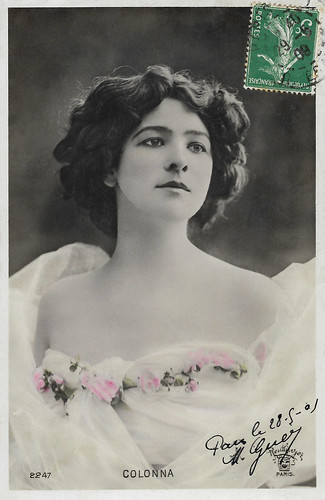
French postcard, no. 2247. Photo: Reutlinger, Paris.
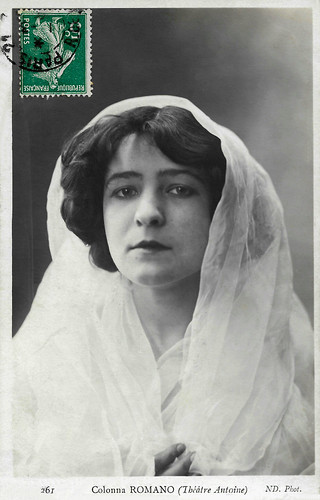
French postcard, no. 261. Photo: ND Phot. Caption: Colonna Romano (Théâtre Antoine).
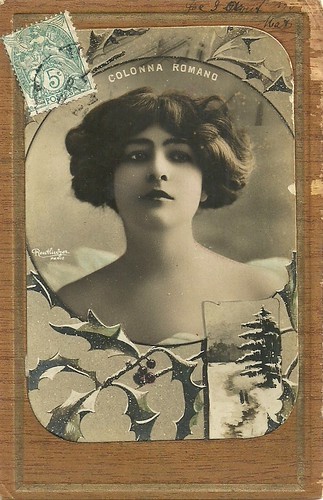
French postcard. Photo: Reutlinger, Paris, c. 1900-1910.
Sources: Fondation Jerome Seydoux Pathe, Wikipedia (French and English), and .

French postcard by KF Editeurs d'art Paris, series 2039. Photo: Reutlinger, Paris.

French postcard. Colonna Romano in the play 'Electre' (Electra) by Euripides.

French postcard in the Nos artistes dans leur loge series, no. 237. Photo: Comoedia.
A favourite model of Renoir
Gabrielle Colonna-Romano aka Colonna or Colonna Romano was born Gabrielle Dreyfuss in Paris in 1883. Wikipedia writes that she used Colonna Romano as a film actress, but on most of the cards in this post (including the one above for a stage role and others from the period before her film career), she was called 'Colonna Romano'.
She was a pupil and devotee of Sarah Bernhardt . In 1913, Colonna Romano became a member of the Comédie-Française and was a sociétaire between 1926 and 1936, when she left the Comédie-Française.
Colonna Romano was famous for her roles as tragediénne, such as in the Euripides play 'Electre' (Electra), and she also gave numerous poetry readings, notably by the Symbolist poet Saint-Pol-Roux.
She was also a favourite model of the Impressionist painter Auguste Renoir and posed for such paintings as 'Jeune femme à la rose' (1913). She had an affair with his son Pierre Renoir until he left her for the actress Vera Sergine .
Colonna-Romano also acted in silent films. Between 1908 and 1913 she appeared in Film d'Art shorts such as Hamlet (Henri Desfontaines, 1908), in which she played Queen Gertrude.
She also acted in modern drama and action films, like Hop-Frog (Henri Desfontaines, 1910), L'Honneur/Legion of Honor (Albert Capellani, 1910) with her then-husband George Grand, Le Scarabée d'or/The Gold-Bug (Henri Desfontaines, 1910), and Antar (N.N., 1912).
IMDb and Wikipedia state that her film L'Honneur dates from 1913 and was made by Henri Pouctal. The mostly more reliable Seydoux-Pathé site gives another name and date, which we use above.

French postcard by. S.I.P., no. 97/20.

French postcard by S.I.P., no. 908/6. Photo: Reutlinger, Paris. Caption: Mardi (Tuesday).

French postcard by FA, no. 275. Photo: Félix. Caption: Colonna Romano, Comédie Française.
Nurse in WWI and resistance fighter in WWII
During the First World War, Colonna Romano was a nurse, according to IMDb .
In England, she met and became friends with Marie Bell who, on her advice, decided to go to the Conservatory.
Romano was married to actor Georges Grand, who died in 1921 of a heart attack at the age of 56. In 1916, while married, she had a relationship with the very young, future filmmaker René Clair, but his best friend Jacques Rigaut was jealous and Romano very free in her relationships... The deluded Clair left for the Red-Cross in 1917.
She was the sixth and final wife of the millionaire press-magnate Alfred Edwards, and after his death, she married in 1939 the actor Pierre Alcover, like her first husband a colleague from the Comédie-Française. IMDb writes that Colonna Romano was a resistance fighter in WWII.
In 1981, Gabrielle Colonna Romano died in Paris at the age of 93. She and Alcover rest in the old cemetery of Rueil-Malmaison. Their granddaughter Cathérine is an actress too. Colonna Romano gave her name to the Colonna-Romano Prize for Classical Tragedy at the National Conservatory of Dramatic Art in Paris.
Colonna Romano can be seen acting in the documentary Un soir à la Comédie-Française/An Evening at the Comédie-Française (Léonce Perret, 1935).

French postcard, no. 2247. Photo: Reutlinger, Paris.

French postcard, no. 261. Photo: ND Phot. Caption: Colonna Romano (Théâtre Antoine).

French postcard. Photo: Reutlinger, Paris, c. 1900-1910.
Sources: Fondation Jerome Seydoux Pathe, Wikipedia (French and English), and .
Published on April 08, 2020 22:00
April 7, 2020
Figaro (1929)
Famous dancer Ernst (Edmond) Van Duren, Arlette Marchal, Marie Bell, and the Romanian actor Genica Missirio played the lead roles in late silent French film Figaro (Gaston Ravel, 1929), It is an adaptation of the 1778 Pierre Beaumarchais play 'The Marriage of Figaro'. Location shooting was done at the Château de Rochefort-sur-Yvelines.
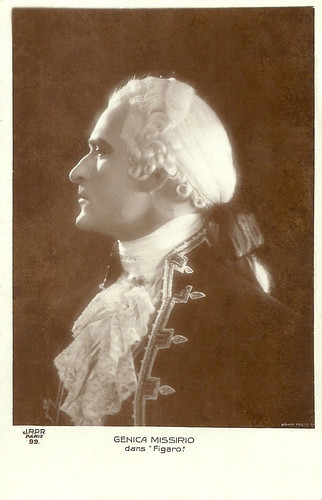
French postcard by J.R.P.R., Paris, no. 99. Photo: Roger Forster. Genica Missirio in Figaro (Gaston Ravel, 1929).

French postcard by J.R.P.R., Paris, no. 301. Photo: Roger Forster. Ernst Van Duren as Figaro in Figaro (Gaston Ravel, 1929).
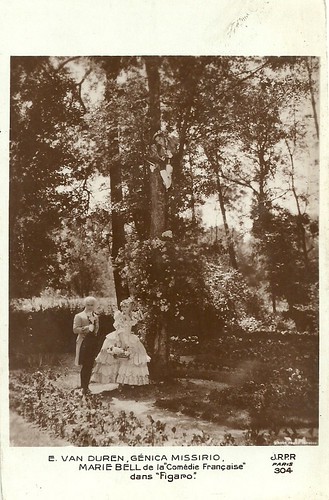
French postcard by J.R.P.R., Paris, no. 304. Photo: Roger Forster. Genica Missirio , Marie Bell , and Ernst Van Duren (up in the tree) in Figaro (Gaston Ravel, 1929).
Three people were crushed to death in the opening-night crowd
Ernst / Ernest/ Edmond Van Duren was a famous dancer, who - together with his dance partner Edmonde Guy - was popular all over Europe and the US in the 1920s. He acted in a handful films, including leads in Manege (Max Reichmann, 1928) and Princesse Mandane (Germaine Dulac, 1928). In 1930 he committed suicide.
Van Duren's last film was Figaro (Gaston Ravel, 1929). Wikipedia and IMDb list Tony Lekain as co-director of Figaro, but according to Ciné-Ressources Lekain was only the set designer.
Van Duren, listed as Edmond Van Duren, had the lead as the title character, opposite Arlette Marchal as Rosine, Marie Bell as Suzanne, Génica Missirio as Bogaerts, and Tony D'Algy as the Count of Almaviva. Other actors were a.o. José Davert and Jean Weber . The cinematography was by Albert Duverger, costumes by Georges Benda.
Figaro (Gaston Ravel, 1929) is an adaptation of the Pierre Beaumarchais play 'La Folle Journée, ou Le Mariage de Figaro' (The Marriage of Figaro), with material also used from its prequel and sequel. This play is the second in the Figaro trilogy, preceded by 'The Barber of Seville' and followed by 'The Guilty Mother'. 'The Marriage of Figaro' opened to enormous success; it was said to have grossed 100,000 francs in the first twenty showings. The theatre was so packed that three people were reportedly crushed to death in the opening-night crowd. Eight years later, the play formed the basis for an opera with a libretto by Lorenzo Da Ponte and music by Wolfgang Amadeus Mozart, also called 'The Marriage of Figaro' (1786).
The Barber of Seville: The Spanish count Almaviva has fallen in love at first sight with the girl Rosine. To ensure that she really loves him and not just his money, the Count disguises himself as a poor college student and attempts to woo her. His plans are foiled by Rosine's guardian, Doctor Bartholo, who keeps her locked up in his house and intends to marry her himself. The Count's luck changes, however, after a chance reunion with an ex-servant of his, Figaro, who is currently working as a barber and therefore has access to the Doctor's home. After being promised money, and afraid the Count will seek revenge on him if he refuses, Figaro devises a variety of ways for the Count and Rosine to meet and talk. The story culminates in the marriage of the Count and Rosine.
The Marriage of Figaro: Figaro's marriage resumed three years after the end of The Barber of Seville when Figaro was promised to become Susanna's husband; both characters are part of the Count's staff in his home. In the three years since Figaro has helped to forge the marriage of the Count and Rosina, the Count has already been bored with his marriage but has noticed Susanna's beauty. The Count tries to assert the Ius primae noctis (the right of the first night), before Figaro's honeymoon, but Figaro is alert. They dress the Countess' page Chérubin as Susanna, but then the Count knocks on the door. Quickly the page escapes through the window, Susanne substitutes for him and the Count offers an apology.
The Guilty Mother: Countess and Chérubin spent a night together, but she thought it wrong, so he left for war and got himself killed. While dying he wrote a final letter, which the Countess kept in a secret drawer in a box made by the Irishman Bégearss. The Countess, though, became pregnant with Chérubin's child. The Count has been suspicious all these years that he is not the father of Léon, the Countess's son, and so he has been rapidly trying to spend his fortune to ensure the boy won't inherit any of it, even having gone so far as to renounce his title and move the family to Paris. As he has nevertheless held some doubts, and therefore has never officially disowned the boy or even brought up his suspicions to the Countess. Meanwhile, the Count has an illegitimate child of his own, a daughter named Florestine. Bégearss wants to marry her, and to ensure that she will be the Count's only heir, he begins to stir up trouble over the Countess's secret. Figaro and Suzanne, who are still married, must once again come to the rescue of the Count and Countess; and of their illegitimate children Léon and Florestine, who are secretly in love with each other.
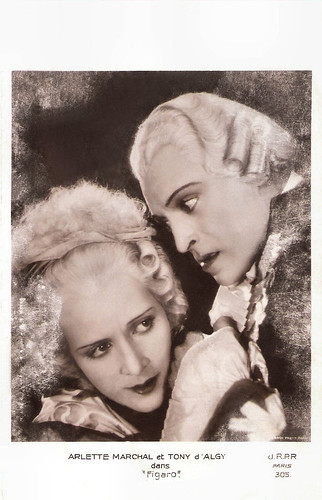
French postcard by J.R.P.R., Paris, no. 305. Photo: Roger Forster. Arlette Marchal and Tony D'Algy in Figaro (Gaston Ravel, 1929).
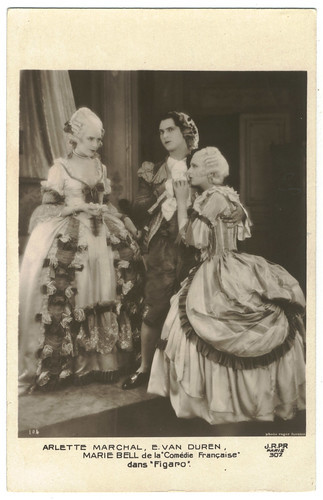
French postcard by J.R.P.R., Paris, no. 307. Photo: Roger Forster. Arlette Marchal , Ernst van Duren and Marie Bell in Figaro (Gaston Ravel, 1929). Collection: Manuel Palomino Arjona (Flickr).
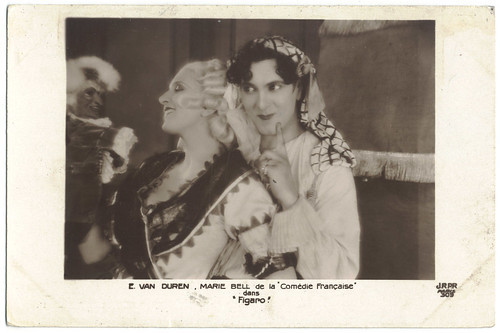
French postcard by J.R.P.R., Paris, no. 309. Photo: Roger Forster. Ernst van Duren and Marie Bell in Figaro (Gaston Ravel, 1929). Collection: Manuel Palomino Arjona (Flickr).
Sources: Ciné-Ressources (French), Wikipedia and IMDb.

French postcard by J.R.P.R., Paris, no. 99. Photo: Roger Forster. Genica Missirio in Figaro (Gaston Ravel, 1929).

French postcard by J.R.P.R., Paris, no. 301. Photo: Roger Forster. Ernst Van Duren as Figaro in Figaro (Gaston Ravel, 1929).

French postcard by J.R.P.R., Paris, no. 304. Photo: Roger Forster. Genica Missirio , Marie Bell , and Ernst Van Duren (up in the tree) in Figaro (Gaston Ravel, 1929).
Three people were crushed to death in the opening-night crowd
Ernst / Ernest/ Edmond Van Duren was a famous dancer, who - together with his dance partner Edmonde Guy - was popular all over Europe and the US in the 1920s. He acted in a handful films, including leads in Manege (Max Reichmann, 1928) and Princesse Mandane (Germaine Dulac, 1928). In 1930 he committed suicide.
Van Duren's last film was Figaro (Gaston Ravel, 1929). Wikipedia and IMDb list Tony Lekain as co-director of Figaro, but according to Ciné-Ressources Lekain was only the set designer.
Van Duren, listed as Edmond Van Duren, had the lead as the title character, opposite Arlette Marchal as Rosine, Marie Bell as Suzanne, Génica Missirio as Bogaerts, and Tony D'Algy as the Count of Almaviva. Other actors were a.o. José Davert and Jean Weber . The cinematography was by Albert Duverger, costumes by Georges Benda.
Figaro (Gaston Ravel, 1929) is an adaptation of the Pierre Beaumarchais play 'La Folle Journée, ou Le Mariage de Figaro' (The Marriage of Figaro), with material also used from its prequel and sequel. This play is the second in the Figaro trilogy, preceded by 'The Barber of Seville' and followed by 'The Guilty Mother'. 'The Marriage of Figaro' opened to enormous success; it was said to have grossed 100,000 francs in the first twenty showings. The theatre was so packed that three people were reportedly crushed to death in the opening-night crowd. Eight years later, the play formed the basis for an opera with a libretto by Lorenzo Da Ponte and music by Wolfgang Amadeus Mozart, also called 'The Marriage of Figaro' (1786).
The Barber of Seville: The Spanish count Almaviva has fallen in love at first sight with the girl Rosine. To ensure that she really loves him and not just his money, the Count disguises himself as a poor college student and attempts to woo her. His plans are foiled by Rosine's guardian, Doctor Bartholo, who keeps her locked up in his house and intends to marry her himself. The Count's luck changes, however, after a chance reunion with an ex-servant of his, Figaro, who is currently working as a barber and therefore has access to the Doctor's home. After being promised money, and afraid the Count will seek revenge on him if he refuses, Figaro devises a variety of ways for the Count and Rosine to meet and talk. The story culminates in the marriage of the Count and Rosine.
The Marriage of Figaro: Figaro's marriage resumed three years after the end of The Barber of Seville when Figaro was promised to become Susanna's husband; both characters are part of the Count's staff in his home. In the three years since Figaro has helped to forge the marriage of the Count and Rosina, the Count has already been bored with his marriage but has noticed Susanna's beauty. The Count tries to assert the Ius primae noctis (the right of the first night), before Figaro's honeymoon, but Figaro is alert. They dress the Countess' page Chérubin as Susanna, but then the Count knocks on the door. Quickly the page escapes through the window, Susanne substitutes for him and the Count offers an apology.
The Guilty Mother: Countess and Chérubin spent a night together, but she thought it wrong, so he left for war and got himself killed. While dying he wrote a final letter, which the Countess kept in a secret drawer in a box made by the Irishman Bégearss. The Countess, though, became pregnant with Chérubin's child. The Count has been suspicious all these years that he is not the father of Léon, the Countess's son, and so he has been rapidly trying to spend his fortune to ensure the boy won't inherit any of it, even having gone so far as to renounce his title and move the family to Paris. As he has nevertheless held some doubts, and therefore has never officially disowned the boy or even brought up his suspicions to the Countess. Meanwhile, the Count has an illegitimate child of his own, a daughter named Florestine. Bégearss wants to marry her, and to ensure that she will be the Count's only heir, he begins to stir up trouble over the Countess's secret. Figaro and Suzanne, who are still married, must once again come to the rescue of the Count and Countess; and of their illegitimate children Léon and Florestine, who are secretly in love with each other.

French postcard by J.R.P.R., Paris, no. 305. Photo: Roger Forster. Arlette Marchal and Tony D'Algy in Figaro (Gaston Ravel, 1929).

French postcard by J.R.P.R., Paris, no. 307. Photo: Roger Forster. Arlette Marchal , Ernst van Duren and Marie Bell in Figaro (Gaston Ravel, 1929). Collection: Manuel Palomino Arjona (Flickr).

French postcard by J.R.P.R., Paris, no. 309. Photo: Roger Forster. Ernst van Duren and Marie Bell in Figaro (Gaston Ravel, 1929). Collection: Manuel Palomino Arjona (Flickr).
Sources: Ciné-Ressources (French), Wikipedia and IMDb.
Published on April 07, 2020 22:00
April 6, 2020
RIP: Honor Blackman (1925-2020)
Yesterday, 6 April 2020, British actress Honor Blackman (1925-2020) passed away at the age of 94. She was best known for playing the Bond girl Pussy Galore opposite Sean Connery in Goldfinger (1964). Blackman became a household name in the 1960s as Cathy Gale in The Avengers in which she showed an extraordinary combination of beauty, brains and physical prowess. After a career spanning eight decades, she died of natural causes unrelated to coronavirus.
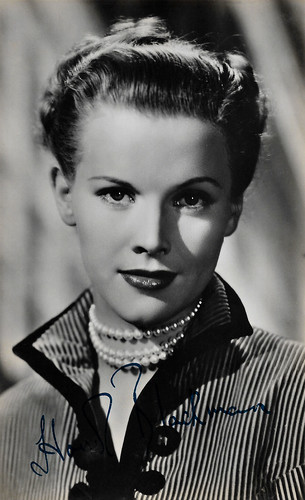
British autograph card.
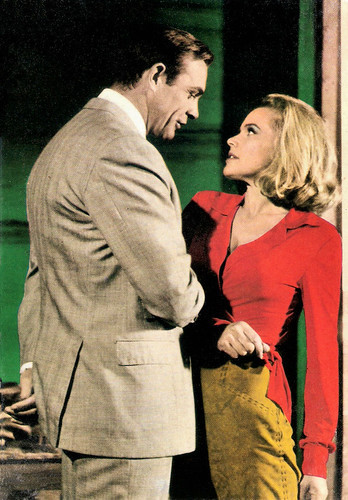
Spanish postcard by Postal Oscarcolor, no. 355. Photo: Sean Connery and Honor Blackman in Goldfinger (Guy Hamilton, 1964).
Leather-clad crimefighter Cathy Gale
Honor Blackman was born one of four children of a middle-class family in London's East End. Her father, Frederick Blackman, was a civil service statistician.
For her 15th birthday, her parents gave her acting lessons and she began her training at the Guildhall School of Music and Drama in 1940. Blackman received her first acting work on stage in London's West End as an understudy for 'The Guinea Pig'. She continued with roles in 'The Gleam' (1946) and 'The Blind Goddess' (1947), before moving into film.
She debuted with Fame Is the Spur (Roy Boulting, 1947), starring Michael Redgrave . Signed up with the Rank Organisation, Blackman joined several other starlet hopefuls who were being groomed for greater fame.
She played small roles in the anthology film Quartet (Ken Annakin, Arthur Crabtree, Harold French, Ralph Smart, 1948), based on short stories by W. Somerset Maugham, the thriller So Long at the Fair (Terence Fisher, Antony Darnborough,1950), with Dirk Bogarde , and the Titanic drama A Night to Remember (Roy Ward Baker, 1958).
Developing a solid footing, she filmed The Square Peg (John Paddy Carstairs, 1958) with comedian Norman Wisdom and A Matter of WHO (Don Chaffey, 1961) with Terry-Thomas.
On television, she played in the Edgar Wallace vigilante series The Four Just Men (1959-1960). She secured her breakthrough when she was cast in 1962 as the leather-clad crimefighter Cathy Gale in the hit British show The Avengers (1962-1964), alongside Patrick Macnee as the bowler-hatted John Steed. Blackman had to learn judo for the role, and her tough persona allied to then daring costume choices – boots and figure-hugging catsuits – ensured she quickly assumed star status. One of its unlikely results was a hit single, 'Kinky Boots', recorded in 1964 with Macnee, which became a Top 10 hit in the U.K. in 1990.
Blackman’s proficiency in martial arts helped her land what became her signature role, that of Pussy Galore, the glamorous villain assisting in Goldfinger’s plot to rob Fort Knox. Goldfinger (Guy Hamilton, 1964) was the third Bond film and was a global hit. Gary Brumburgh at IMDb : "Blackman went toe to toe with Sean Connery 's womanizing "007" and created major sparks on screen, managing to outclass the (wink-wink) double meaning of her character's name."
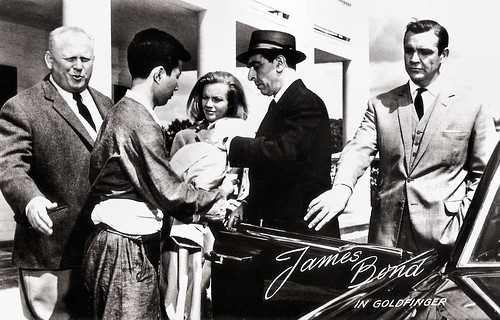
Dutch postcard by 't Sticht, Utrecht, no. AX 6262. Gert Fröbe, Honor Blackman, Martin Benson and Sean Connery in Goldfinger (Guy Hamilton, 1964).
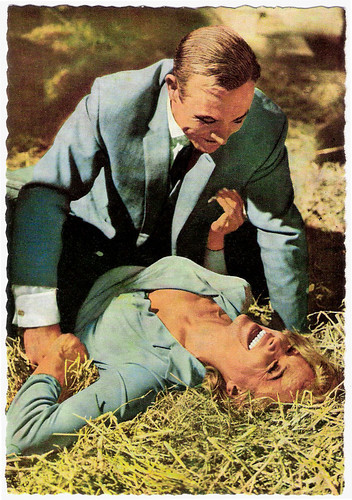
German postcard. Photo: P.A. Reuter. Sean Connery and Honor Blackman in Goldfinger (Guy Hamilton, 1964).
A lot of life left to live
After her rise to mainstream fame, Honor Blackman made noticeable appearances in such films as Jason and the Argonauts (Don Chaffey, 1963) as the vengeful goddess Hera, the Western Shalako (Edward Dmytryk, 1968) and The Virgin and the Gypsy (Christopher Miles, 1970) with Franco Nero .
Simon Murphy and Andrew Pulver in The Guardian : "while she worked steadily in film, her TV work was higher profile, and included guest appearances in Columbo, Minder and Doctor Who. In 1990, she was cast in a regular role in the ITV sitcom The Upper Hand, playing the glamorous mother of the lead female character. Blackman expressed her fondness for the role, saying it “made women who had just retired and felt they’d been put on the backburner realise they had a lot of life left to live”."
She earned raves on stage as the blind heroine of the thriller 'Wait Until Dark' as well as for her dual roles in 'Mr. and Mrs.', a production based on two of Noël Coward's plays. She also appeared on stage in 'The Sound of Music' (1981), 'My Fair Lady' (2005-2006) and 'Cabaret' (2007).
She was a staunch republican and turned down a Commander of the British Empire (CBE) in 2002 to avoid being a “hypocrite”. More recently, she joined a campaign to demand compensation payments for pensioners who lost savings in the Equitable Life scandal.
Honor Blackman was married to Bill Sankey from 1948 to 1956. After their divorce, she married British actor Maurice Kaufmann (1961–1975). They appeared together in the slasher film Fright (Peter Collinson, 1971) and some stage productions. They adopted two children, Lottie (1967) and Barnaby (1968). After her divorce from Kaufmann, she did not remarry and stated that she preferred being single. She enjoyed watching football. Blackman died at her home in Lewes in 2020, aged 94, from natural causes.
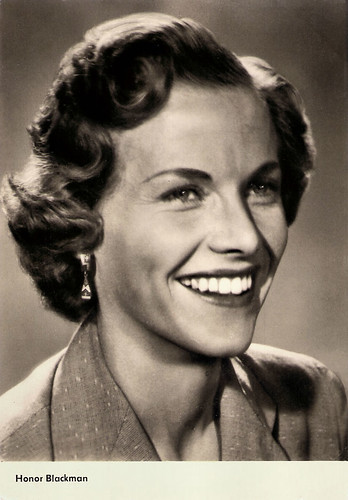
East-German postcard by VEB Progress Film-Vertrieb, Berlin, no. 1602, 1961. Honor Blackman in The Delavine Affair (Douglas Peirce, 1954).
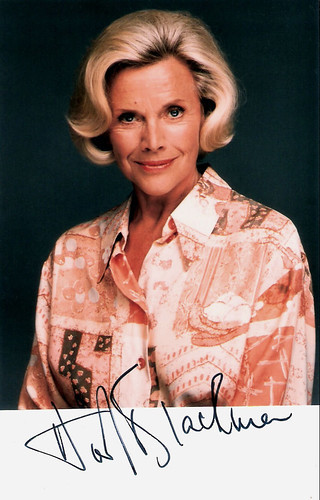
Autograph card.
Sources: Simon Murphy and Andrew Pulver (The Guardian), (IMDb), Wikipedia and .

British autograph card.

Spanish postcard by Postal Oscarcolor, no. 355. Photo: Sean Connery and Honor Blackman in Goldfinger (Guy Hamilton, 1964).
Leather-clad crimefighter Cathy Gale
Honor Blackman was born one of four children of a middle-class family in London's East End. Her father, Frederick Blackman, was a civil service statistician.
For her 15th birthday, her parents gave her acting lessons and she began her training at the Guildhall School of Music and Drama in 1940. Blackman received her first acting work on stage in London's West End as an understudy for 'The Guinea Pig'. She continued with roles in 'The Gleam' (1946) and 'The Blind Goddess' (1947), before moving into film.
She debuted with Fame Is the Spur (Roy Boulting, 1947), starring Michael Redgrave . Signed up with the Rank Organisation, Blackman joined several other starlet hopefuls who were being groomed for greater fame.
She played small roles in the anthology film Quartet (Ken Annakin, Arthur Crabtree, Harold French, Ralph Smart, 1948), based on short stories by W. Somerset Maugham, the thriller So Long at the Fair (Terence Fisher, Antony Darnborough,1950), with Dirk Bogarde , and the Titanic drama A Night to Remember (Roy Ward Baker, 1958).
Developing a solid footing, she filmed The Square Peg (John Paddy Carstairs, 1958) with comedian Norman Wisdom and A Matter of WHO (Don Chaffey, 1961) with Terry-Thomas.
On television, she played in the Edgar Wallace vigilante series The Four Just Men (1959-1960). She secured her breakthrough when she was cast in 1962 as the leather-clad crimefighter Cathy Gale in the hit British show The Avengers (1962-1964), alongside Patrick Macnee as the bowler-hatted John Steed. Blackman had to learn judo for the role, and her tough persona allied to then daring costume choices – boots and figure-hugging catsuits – ensured she quickly assumed star status. One of its unlikely results was a hit single, 'Kinky Boots', recorded in 1964 with Macnee, which became a Top 10 hit in the U.K. in 1990.
Blackman’s proficiency in martial arts helped her land what became her signature role, that of Pussy Galore, the glamorous villain assisting in Goldfinger’s plot to rob Fort Knox. Goldfinger (Guy Hamilton, 1964) was the third Bond film and was a global hit. Gary Brumburgh at IMDb : "Blackman went toe to toe with Sean Connery 's womanizing "007" and created major sparks on screen, managing to outclass the (wink-wink) double meaning of her character's name."

Dutch postcard by 't Sticht, Utrecht, no. AX 6262. Gert Fröbe, Honor Blackman, Martin Benson and Sean Connery in Goldfinger (Guy Hamilton, 1964).

German postcard. Photo: P.A. Reuter. Sean Connery and Honor Blackman in Goldfinger (Guy Hamilton, 1964).
A lot of life left to live
After her rise to mainstream fame, Honor Blackman made noticeable appearances in such films as Jason and the Argonauts (Don Chaffey, 1963) as the vengeful goddess Hera, the Western Shalako (Edward Dmytryk, 1968) and The Virgin and the Gypsy (Christopher Miles, 1970) with Franco Nero .
Simon Murphy and Andrew Pulver in The Guardian : "while she worked steadily in film, her TV work was higher profile, and included guest appearances in Columbo, Minder and Doctor Who. In 1990, she was cast in a regular role in the ITV sitcom The Upper Hand, playing the glamorous mother of the lead female character. Blackman expressed her fondness for the role, saying it “made women who had just retired and felt they’d been put on the backburner realise they had a lot of life left to live”."
She earned raves on stage as the blind heroine of the thriller 'Wait Until Dark' as well as for her dual roles in 'Mr. and Mrs.', a production based on two of Noël Coward's plays. She also appeared on stage in 'The Sound of Music' (1981), 'My Fair Lady' (2005-2006) and 'Cabaret' (2007).
She was a staunch republican and turned down a Commander of the British Empire (CBE) in 2002 to avoid being a “hypocrite”. More recently, she joined a campaign to demand compensation payments for pensioners who lost savings in the Equitable Life scandal.
Honor Blackman was married to Bill Sankey from 1948 to 1956. After their divorce, she married British actor Maurice Kaufmann (1961–1975). They appeared together in the slasher film Fright (Peter Collinson, 1971) and some stage productions. They adopted two children, Lottie (1967) and Barnaby (1968). After her divorce from Kaufmann, she did not remarry and stated that she preferred being single. She enjoyed watching football. Blackman died at her home in Lewes in 2020, aged 94, from natural causes.

East-German postcard by VEB Progress Film-Vertrieb, Berlin, no. 1602, 1961. Honor Blackman in The Delavine Affair (Douglas Peirce, 1954).

Autograph card.
Sources: Simon Murphy and Andrew Pulver (The Guardian), (IMDb), Wikipedia and .
Published on April 06, 2020 22:00
Paul van Yperen's Blog
- Paul van Yperen's profile
- 13 followers
Paul van Yperen isn't a Goodreads Author
(yet),
but they
do have a blog,
so here are some recent posts imported from
their feed.



